
How to Build an Awesome Technical Writing Portfolio and 5 Excellent Examples

Jessica Michael
The technical writing industry continues to grow, with technical writing jobs on the increase. The U.S. Bureau of Labor Statistics lists the median salary of a technical writer in the U.S as $78,060 per year, with higher wages for senior technical writers with more experience. Many technical writers work remotely and have good opportunities for career advancement. This makes it a great career choice, but it also means there's quite a bit of competition. In order to stand out, you're going to need an impressive portfolio. Luckily, we're here to help you learn how to build a technical writing portfolio that can get you hired.
What is a technical writer?
Technical writing involves taking complex information and breaking it down into easy-to-understand formats such as guides, manuals, technical materials, and white papers. Technical writers are subject matter experts who often have a background in the industry they write about, including engineering, computer programming, or healthcare management. Many technical writers work in-house creating documents that help end users navigate a particular technology. Most technical writing is designed for the company's or organization's internal use, helping employees utilize a systems platform or summarizing performance reports for C-Suite executives.
What is a technical writing portfolio?
A technical writing portfolio is a collection of samples of your technical writing projects as well as information about you that a prospective employer might want to know. Professional experience, education, and any technical writing certificates you've earned might be included. These days, most writing portfolios are digital and are often hosted on digital portfolio sites or created as websites. Technical writing portfolios tend to be more professional and straightforward than other writing portfolios and include more details about educational and professional background. They're designed so that an employer can access examples of your work easily and evaluate quickly if you're a good fit for the role.
The importance of a technical writing portfolio
Most technical writers work as employees at larger companies and organizations, although some are able to freelance. Whether you are looking to get hired in-house or you need freelance clients, a portfolio is the most effective way to showcase your technical writing, highlight your skillset , and present your educational background and career experience. In fact, many potential employers require a digital portfolio as part of the hiring process. Having a well-designed and professional looking portfolio that emphasizes your best work is a must-have if you want to impress potential employers or clients.
What to include in a technical writing portfolio
Digital portfolios are a chance to emphasize your unique qualifications. And while there is always room to show some personality, technical writing portfolios are professional in tone and simple in design. A good portfolio includes:
Technical writing samples . The most important part of your portfolio is your samples. This is what employers and clients are going to spend the most time on because your examples of technical writing speak directly to your abilities. For that reason, you'll want to balance including enough samples to show depth of experience with being sure to include the absolute best of what you've done. You can include all of your best work on a featured projects page, or if you have experience in multiple areas , you may want to display each type of content on a separate page. And if you're just starting out and don't have enough examples of your work, don't worry. We'll address that further along in this article.
Biographical information . Biographical information is divided into two types: personal and professional. In a technical writer's portfolio, you'll want to accentuate your professional experience, but that doesn't mean you can't also include some interesting personal facts as well. The best way to judge if you should include a personal fact is to decide if it would be appropriate to share that piece of information in a job interview. Your About Me can be a section or a page, and you can keep it short by separately featuring educational and work experience, or you can include all of your information in your bio.
Resume/CV. Technical writing often requires subject matter expertise, either from a career background in a subject or an educational background in that subject. Including your resume really helps to boost your authority, and can be done by featuring that information on its own page, in a widget, or with a button that links to a document. Whatever you choose, make sure it's easy for someone to find, and if you have any special training in technical writing, be sure to include that, too.
Contact Information. Contact information includes a contact form that can be on a separate page or located at the bottom of your landing page, as well as any social media buttons you wish to include. Social media access is more important if you are also advertising that you write social media posts or run social media campaigns, but many employers now also check social accounts. LinkedIn can be especially useful, but be sure you only link accounts that will help your chances of getting hired. You may also want to display your email in your sidebar or header as well.
Senior level technical writing portfolio
If you have a ton of experience and are designing a portfolio to upscale into a better position , a resume becomes an even more important component of your portfolio. Since you'll have more projects to choose from, only include your most impressive samples. We also recommend testimonials from previous clients and employers. Sticking to a more professional tone and simple design aesthetic can help to underline your impressive abilities and background.
Entry level technical writing portfolio
If you're just breaking into becoming a technical writer, figuring out how to build a technical writing portfolio with no experience can seem intimidating. It's important to have an excellent portfolio with professional design, because it will often be your first impression and can convince someone to take a chance on you. Spend more time on your educational and career background sections and make your About Me interesting and personable. Don't be afraid to include samples of your other types of writing work. And create a multitude of "mock" sample projects (many technical writing certificate programs will have you create these). As long as you define them as mock samples, they're a great way to show your potential.
5 Technical Writing Portfolio Examples We Love
1. marcus taylor.
View Marcus' portfolio here: www.mtwriting.com
Marcus Taylor is a technical writer and thought leader who specializes in Healthcare IT, SaaS, cloud computing, machine learning, agile development and data privacy. Marcus showcases his impressive experience by starting his portfolio with his bio. He highlights his areas of expertise as well as his publishing history in heavy-hitters like Forbes, Hacker Noon, and Tech Radar . Four beautiful button images mirror his nav bar and link to an About page, a Portfolio page, a Contact page, and his full resume. Marcus succeeds in maximizing the impact of formidable experience by including easy-to-read text on his About and Resume pages. He balances this with a Portfolio page in a sleek grid design that allows a site visitor to look up an article by title or by type of content (press release, healthcare, public policy, event materials, etc). This allows potential clients to key into exactly the type of work sample they'd like to see from him.
What we like best: Marcus knows he has the experience to back up his technical writing, and he makes sure to show that in his portfolio in several different ways. You don't need to resort to gimmicks if your work speaks for itself.
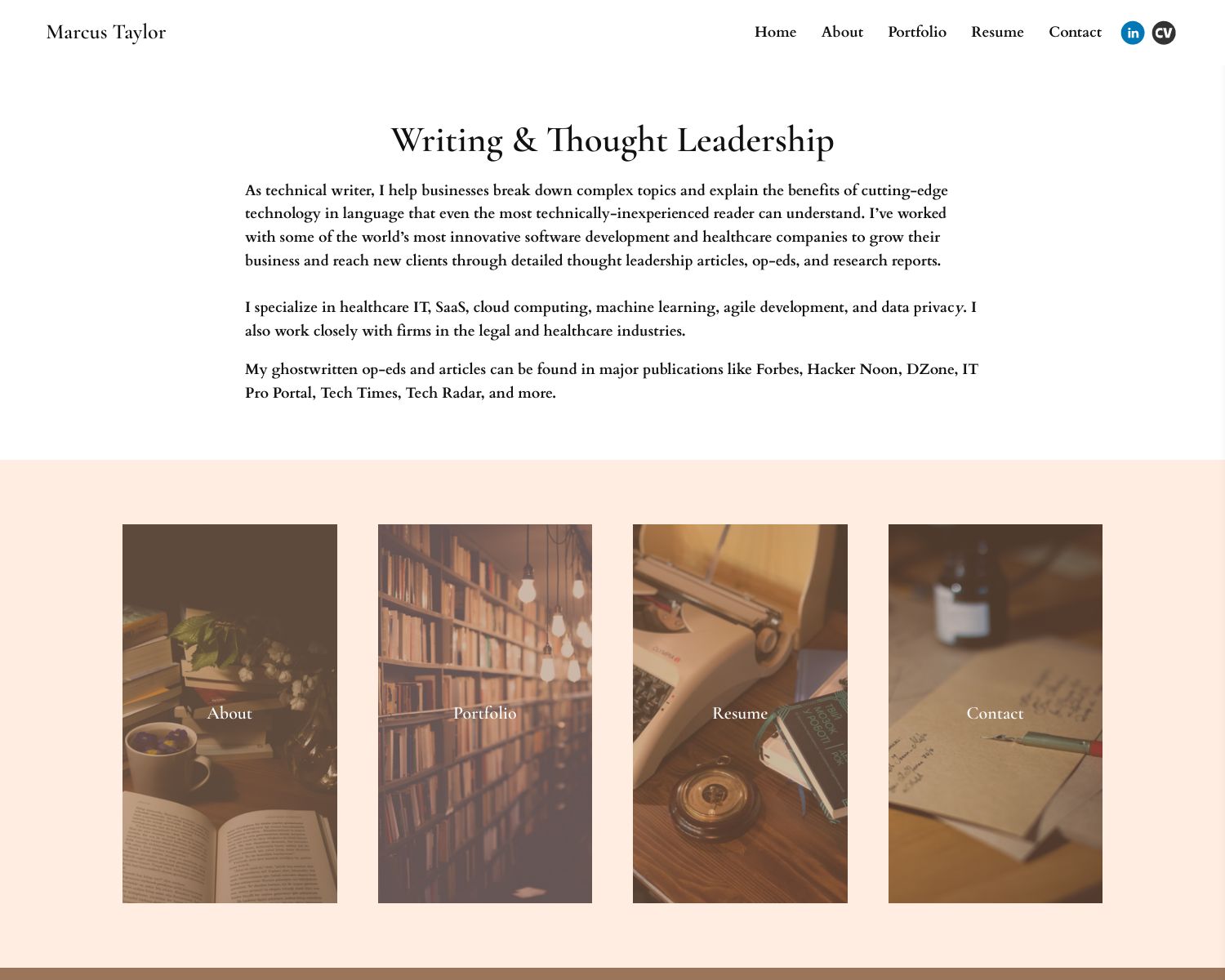
2. SaDesia Giles
SaDesia Giles is a ServiceNow technical writer. SaDesia's landing page features a welcoming bio pic and short About section. A primarily black and white design with large faded image headers creates a professional and understated aesthetic. Her two-column education page features photos of her diplomas and certificates alongside descriptions which give her a chance to emphasize her abilities. She utilizes a grid layout on a projects page, with simple graphic images that link to each project in full. Future clients can easily view her work while getting to know more about her background.
What we like best: SaDesia underscores her great qualifications, from education to experience, while still managing a welcoming tone. You can maintain professionalism while also giving a sense of who you are.

3. Dustin Lewis
View Dustin's portfolio here: www.bydustinlewis.com
Dustin Lewis is a technical writer who also specializes in UX writing and advertising. His two-page website design immediately hits you with his featured work on his landing page. Large image buttons lead to a dialogue box that summarizes each project and allows the user to choose whether or not to view it in its entirety. His black header packs a motto with a punch, an example of his copywriting skills in itself. He keeps the black as his background on his second page, with a more casual About Me section and a friendly picture, beneath which you can easily find his contact form.
What we like best: Including a dialogue box with a project summary lets future clients decide how much of each individual project they want to see. It gives them plenty of information without making them dig through every sample.

4. Marie Daland
View Marie's portfolio here: www.mariedaland.com
Marie Daland is a senior-level copywriter, content strategist, and technical writer. Marie's layout makes great use of her nav bar, dividing her site into pages that each highlight a different type of content. Her header is repeated across her site's pages and includes a professional profile pic, a subscribe button for her email list, and a menu of social media buttons so you can follow her on any platform. Each page sports a dark gray background with a grid layout that features the best samples of her work in each content area. She includes more than enough samples to impress without overly cluttering the page. Her About page cleverly integrates a widget that lets an interested client view her resume right on the page.
What we like best: Your portfolio is also a reflection of your personal brand. By including social media, subscribe options, and smartly incorporated widgets, you become more than the sum of your work samples.
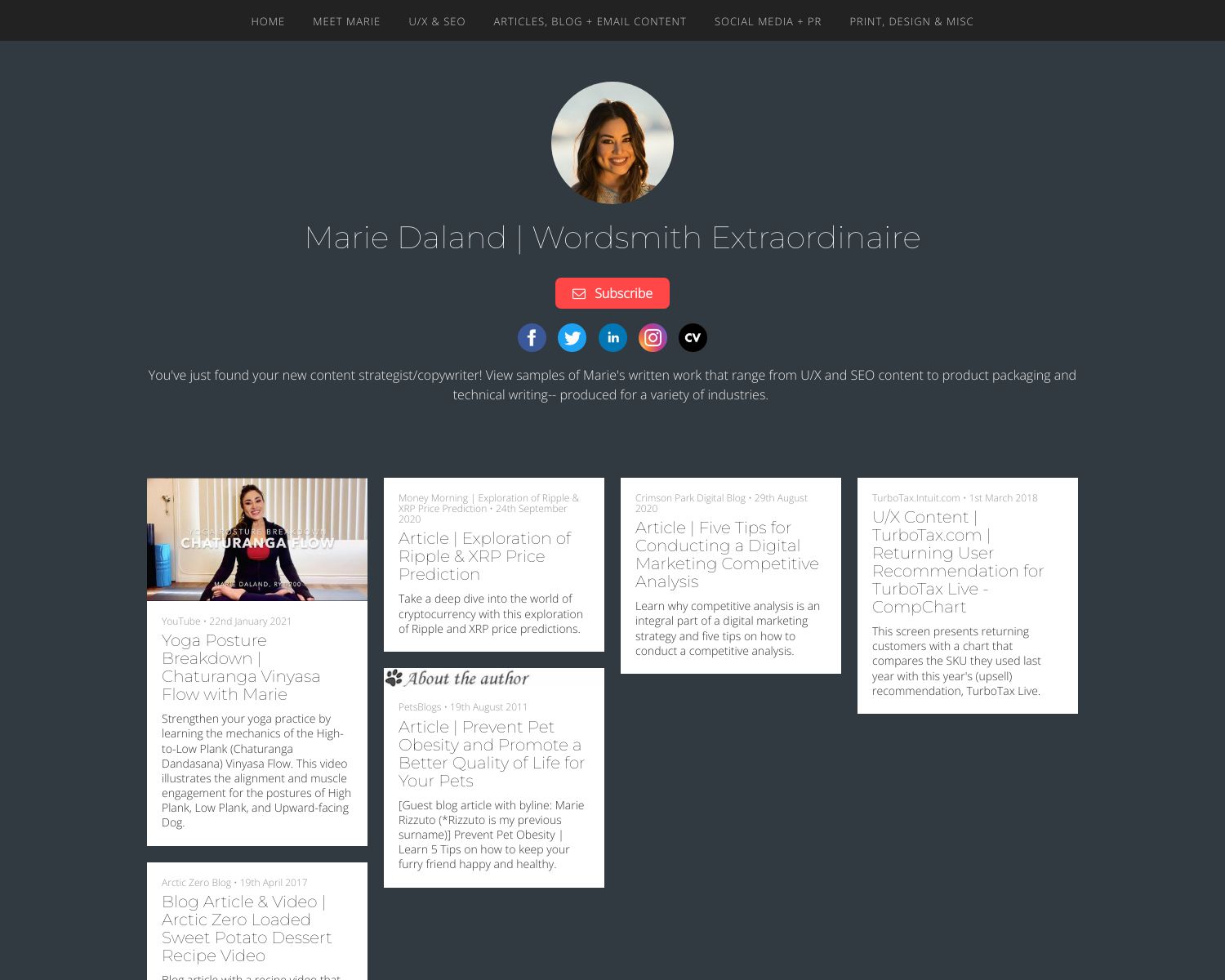
5. Helen Abbott
View Helen's portfolio here: www.helenjabbott.com
Helen Abbott is a technical writer with more than 20 years of experience. Helen chooses a light gray background with header text in red, creating a simple but impactful color scheme. Her side bar includes a bio pic, her social media buttons, and a nav menu that divides her site into "Work" and "Play" pages. She keeps this nav bar across all pages so the site remains easy to navigate wherever you land. A grid layout spotlights her work samples which emphasize only her best examples. And her "Play" pages feature her audio recordings on SoundCloud and her YouTube music videos.
What we like best: Think beyond the usual social media buttons. If you have a presence on other platforms, it can help to round out an employer's impression of you by including them, as long as the content would be considered appropriate in a professional setting.
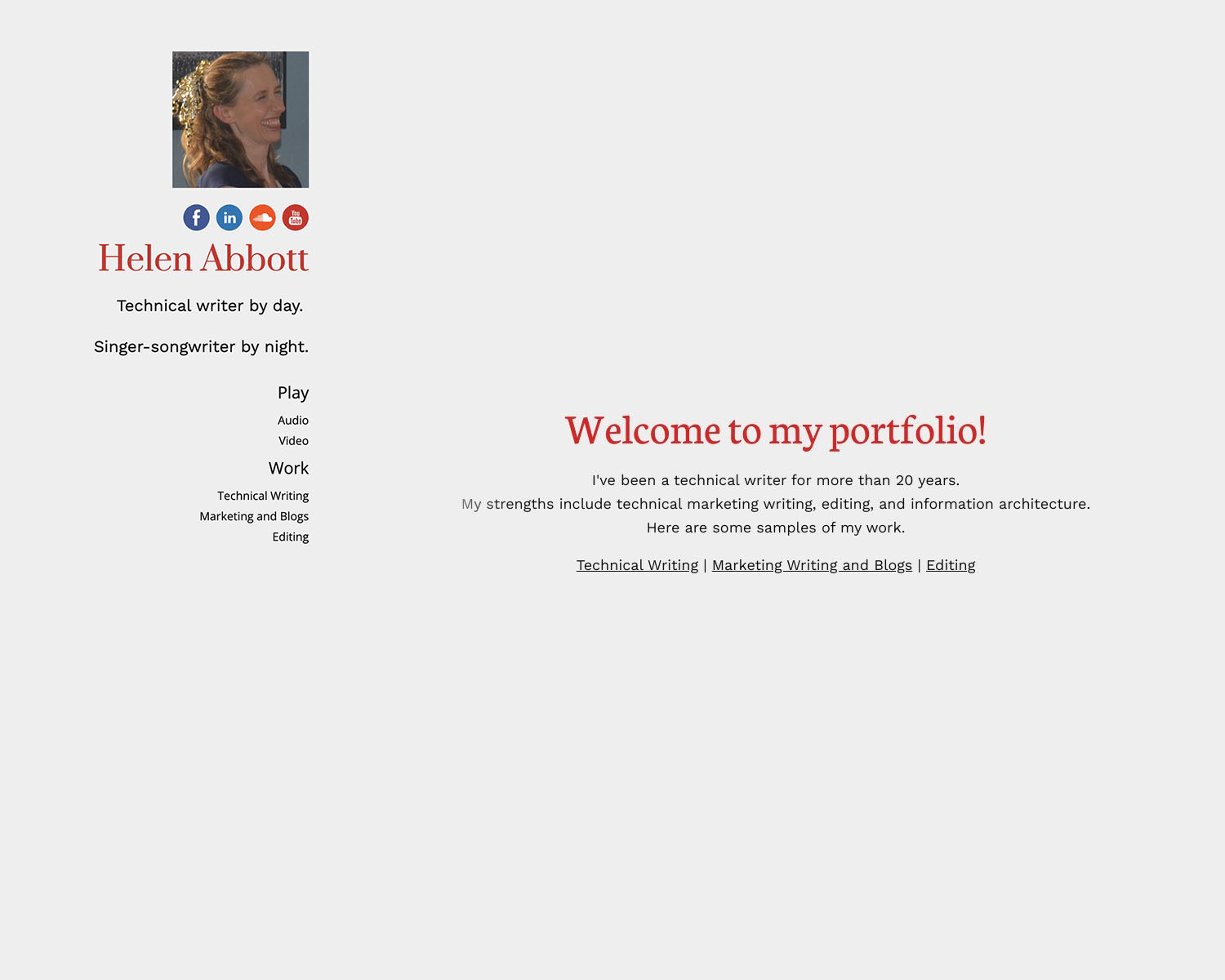
It's your turn to build a technical writing portfolio
Now that you know the basics of what to include in a technical writing portfolio, and you've seen some different examples to inspire you, it's time to get to work on your own portfolio. First, gather up your best work samples and decide how you want to organize them. (Tip: Journo Portfolio makes this easy with embedded tags that let users search your samples by category.) Next, browse templates to get an idea of what design you want for your portfolio. Now you're ready to upload and create a technical writing portfolio to impress.\ Building a technical writing portfolio doesn't have to be overwhelming or take a lot of time. Journo Portfolio's user interface makes it easy and fast to design a professional digital portfolio that's guaranteed to get you noticed. Browse our templates today to get started!

Introducing Our New & Improved Portfolio Editor

How to Create a Writing Portfolio for Freelancers

Jamie Mendes
How to craft a stunning photography portfolio from scratch, curated by journo portfolio.
Subscribe to a monthly email of useful links, tips and advice for people interested in portfolio-building.
No spam, ever. We take your data privacy seriously and you can one-click unsubscribe at any time.
Prefer English?

How to create a Technical Writing Portfolio

Linda Ikechukwu
08 April, 2022
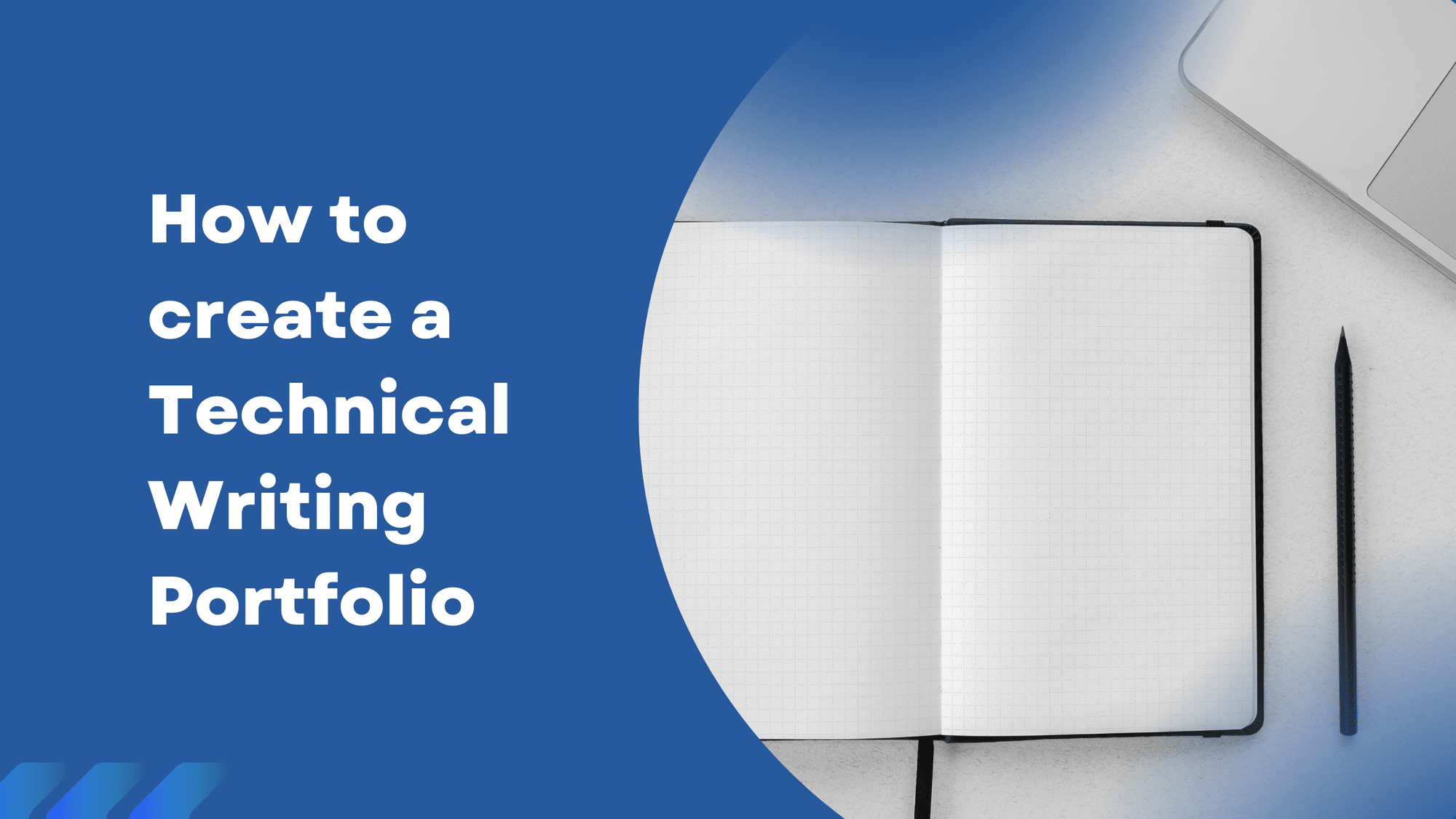
Whether you’re looking to land a full-time technical writing job or freelance contract, you’ll almost always be asked to submit your technical writing portfolio.
A technical writing portfolio is your opportunity to show your potential employers the range of your writing abilities, thought processes, and other valuable complimenting skills. It could be the decisive factor in whether you get invited to an interview.
Tom Johnson of I’dratherbewriting once mentioned that his portfolio was what got him his first tech writing job, even though he wasn’t the most experienced of the bunch.
In this article, I’ll share some best practices to keep in mind when putting together your tech writing portfolio. I'll also try to provide answers to some of the most common questions I've received regarding creating a technical writing portfolio.
Creating/selecting samples for your technical writing portfolio
A technical writing portfolio is simply a showcase of your best tech writing samples and should contain at least 3-5 samples.
Regardless of your level of experience, here are some general guidelines to keep in mind when putting together your samples:
- Put your best foot forward : As I said, your tech writing portfolio should be a showcase of your best technical writing samples. But how do you even know what your best writings are? They're the ones where you took a topic that was really complex (and very foreign) and wrote something that made the topic ridiculously easy to understand; the ones for which you've received several positive feedback.
- Showcase different types of writing : Technical writers in the software industry create different types of writings, such as tutorials, conceptual or explainer guides, reference documents, API docs, e.t.c. Your portfolio should feature different types of writings to demonstrate flexibility.
- Showcase samples relevant to the technical writing niche you want to work in : Employers want to see that you can produce the kind of content they’re looking for. If you want to work in developer documentation, then your samples should be focused on developer docs. If you want to work in user-focused docs, then your samples should be in that line. And if you want to work in developer marketing or technical content marketing, then the majority of your samples should also follow that line.
- Keep your samples brief : Recruiters or hiring managers want to be able to quickly see that you have the skills they’re looking for. So, as much as possible, keep your writing samples brief (1000 -1500 words) and be sure that they’re easily scannable.
For experienced tech writers
If you've worked as a technical writer before, you'll already have some good writing samples. Choose the projects with interesting backstories and challenges — those that really pushed you to your limits.
What if most of your writing samples are proprietary, paywalled, or protected by an NDA? This is a question I’ve heard from most technical writers. If that’s the case, then ask your employers if you delete confidential names and information from your work and showcase fragments of it.
If they ask why, or if you’re planning to leave, just say: “I wanna keep my portfolio updated the same way I keep my resume updated, so I don't lose sight of my work”.
If they refuse, then you should consider working on samples for the sole purpose of including them in your portfolio, following the recommendations for newbie writers below.
For newbie tech writers
As a newbie tech writer, you probably don’t have any writing samples under your belt. Regardless, you need to create a portfolio to apply for tech writing jobs. Here are some suggestions:
- Contribute to open-source docs on your own : Many open-source projects need help with docs, so It’s a good place to start. Contributing to open source is a great idea because the skills you get such as usage of Git, GitHub, and Markdown are skills that are used on a daily basis by technical writers across the globe. Here's a huge list of some open-source communities that need docs help and how you can get started. Also, here’s a guide on how to contribute to open-source projects and a guided tour to help you learn the fundamentals of git.
- Contribute to open-source docs through curated programs : Programs like Outreachy and Google Season of Docs , are designed to help people contribute to open source docs in a structured manner and under the guidance of mentors.
- Freelance tech blogging : You could also write tutorials or explainer articles for some of the tech publications or content agencies mentioned in my ‘ how to make money as a freelance tech writer ’ article.
- Do documentation revamps : Take a look at some poorly written documentation, and rewrite it to make it better. Then in your portfolio, discuss refinements you made and why.
- Self-write/volunteer : You can start publishing articles or tutorials about your favourite tech products. You can also volunteer to create user guides/ documentation/ articles for your favourite startups. Who knows? They might just even end up hiring you.
Presenting your technical writing portfolio
Now that you’ve successfully created/gathered sample writings for your tech writing portfolio, how do you present it? Where do you host it? Here are some ideas:
- A markdown file in your personal repo (GitHub or GitLab).
- A dedicated page on your personal website or blog.
- A notion doc
Another thing to keep in mind is to give context to all your writing samples. Don’t just present a list of links. For each of your samples, tell the behind-the-scenes story.
- Why are you proud of this piece of content
- What challenges did you face during the course of its creation
- What skills (save for writing) did you have to employ to get the job done?
- What's the impact of the content? What problems did it solve? e.t.c
- What tools did you use?
All this information serves to give recruiters more details about you, your writing process, and your thought process.
For example, in my own technical writing portfolio (which I cannot link to because it contains some NDA samples), I highlight one of the documents I wrote for a data pipeline startup. I stated that I was particularly proud of that document because prior to that, I had never heard of the startup's product or a data analytics pipeline. So, it took a lot of researching and interviewing the company's engineers, marketers, and users to write that piece. And in the end, it turned out so well.
Start creating that tech writing portfolio now. Don’t procrastinate. Start now.
Here’s six example technical writing portfolios in case you need some inspiration.
Remember to be obsessive in your proofreading. Make sure to eliminate any spelling, grammar, or typographical errors. Don’t give the hiring manager an easy way to disqualify your application!
Good luck! And if you need someone to look through your portfolio, you can always reach out to me on Twitter .
For more tips to help you become a better technical writer and grow in your career, subscribe to my newsletter below!
Further reading
- Document yourself. Practical tips for low(er) stress portfolio
- 6 Inspiring Technical Writing Portfolios (+ my new portfolio)
- Buy me a coffee to help keep this site running.
- Follow us on Twitter for more technical writing, technical content marketing, and developer advocacy insights.
- Subscribe to the newsletter to receive more content like this directly in your inbox.
More articles you might like:
My review of the technical writer certification course from technical writer hq., tccs #4: tips for freelancing as a technical writer and starting a technical content marketing agency with william., get your technical writing career off the ground..
Join over 1700+ subscribers just like you . Every month, I'll send you new articles and expert interviews published on the blog, so you'd never miss out. I'll also send you a curated list of other valuable resources on technical content creation across the internet, as well as fully-remote technical writing gigs/jobs to help you land your dream job.
10 Great Examples Of Technical Writing Portfolios
While the ability to write is nothing special, it is not necessarily easy to achieve your goal with text. The content can be uninteresting, chaotic, or wander around the topic without creating an understanding of its original idea. We will look at some of the best examples of technical writing portfolios that brought a lot of business to their owners. But before that, let us learn more about the art of technical writing.
Who is a technical writer?
Forms of technical writing:.
Technical writers’ skills are used to complement a wide range of copywriting services, including:
10 Examples of Great Technical Writing Portfolios:
1. janette marie novack.
This is a great example of a clean and efficient portfolio with several categories. Janette shows off a good variety of copywriting samples she has at her disposal. It is very much focused on a straightforward approach that will help you out when looking for a more pragmatic, serious-minded customer.
2. Rolando Montecalvo
This portfolio shows extreme versatility, wide-ranging interests, and the ability to find the right tone for every audience. It has a very strong bio and a great range of projects. Take note of the tone you use in your bio, as it should be reflective of the work you’re looking to land. This one is also hosted on a customizable portfolio website which will take out the hustle of creating your website.
3. Elise Dopson
4. john espirian.
Looking at this portfolio, as a potential client, I’d be immediately drawn to it. The web design is very clear and to the point and the visuals are pleasing. I think he does great work “selling” his services by immediately answering the customer’s questions in the section “Why bother hiring a writer?”
5. Wendy Holland
This portfolio takes a formal tone, with sections that are centered on Wendy’s services and results. Take note of the example, if you’re a humor columnist, your bio might be lighthearted and use playful language. If you’re a PR professional, you might take a more conservative approach, and so on.
6. Katelyn Petty
Another spotless and minimalistic design that I enjoy, the portfolio highlights all the most important sections, such as the sample categories and her areas of expertise. What I like about this one is the chat section, which allows the client to ask any questions they may have.
7. Samar Owais
8. enlighten writing.
Mahesh has organized its portfolio into clear sections with company logos and thumbnails in each of them to add credibility. He also included testimonials which I think makes all the difference to the potential client
9. Megan Nye
She instantly highlights “killer content for your financial business.” I love how clear and direct she is for potential clients.
10. Stray Goat Writing Services
What is technical writing, 5 essential technical writing skills:, 1. clear and concise writing.
It’s easy to get lost in the middle of industry vocabulary and complicated definitions. In technical writing, it’s fundamental to keep the text clear, concise, and easy to read. The too-promiscuous and complicated form makes the text illegible.
2. Research and Analytical Skills
3. communication: understanding the audience.
You can have the technical knowledge and be a master in your field, but if you can’t transfer knowledge clearly, then technical writing might not be for you. Besides having a clear style, understanding your audience is key to good communication. For example, writing articles for people with no knowledge of the subject requires a completely different approach than writing for experts.
4. Maintaining an Interesting Technical Text
It’s easy to make a technical text boring and monotonous. The reader will rush at breakneck speed, as long as his torment ends as soon as possible, and this is not the point. It is especially easy to fall into the trap of boredom in technical copywriting because such texts contain a lot of detailed information. The best technical copywriters have an instinct that makes them find the golden mean between the detail of the text and its curiosity and reader-friendly form. There are many ways to do this. For example, you can:
5. Technical Knowledge
As a technical writer, one must have at least a basic understanding of the field they are writing about. More complex technical writing documents require more knowledge. Not to mention the specific industry vocabulary. Most technical copywriters have extensive experience in their chosen field (thanks to a previous career or education). The best advice for those just starting is to build your portfolio slowly and carefully. It is worth being picky in the projects undertaken. They can make a big difference in future ventures. As you can see technical copywriters face a unique challenge. Providing products and services that are easy to understand, yet attractive to readers. This requires the person writing the technical text to combine two different fields – knowledge and technical talent with writing skills and an appropriate linguistic workshop. It is difficult to find such a combination, and the consequence of combining these fields is the fact that good technical writers enjoy great popularity and money.
Rafal Reyzer
Hey there, welcome to my blog! I'm a full-time entrepreneur building two companies, a digital marketer, and a content creator with 10+ years of experience. I started RafalReyzer.com to provide you with great tools and strategies you can use to become a proficient digital marketer and achieve freedom through online creativity. My site is a one-stop shop for digital marketers, and content enthusiasts who want to be independent, earn more money, and create beautiful things. Explore my journey here , and don't miss out on my AI Marketing Mastery online course.

How to create a freelance technical writing portfolio from scratch

For a freelance technical writer, a technical writing portfolio is as important as a resume when applying for technical writing gigs.
The concept of having a technical writing portfolio is no longer something new to the average freelance technical writer, especially for technical writers who have been in the game for quite some time, and have been able to land some technical writing gigs from different clients.
It’s undoubtedly true that having a well-organized and personalized technical writing portfolio that is niched down to what you write about has a major role to play when it comes to landing a writing gig because no client would want to hire someone who has no experience.
So how do you create a technical writing portfolio when you don’t have any clients or samples yet?
This article will show you how to create a technical writing portfolio from scratch, which in turn enables you to grow your technical writing career and help you become ready to land that huge technical writing gig.
Egy online kaszinó potenciális alkalmazottjának rendelkeznie kell olyan technikai írói portfólióval, amely bemutatja, hogy képes az iGaming iparággal kapcsolatos világos és informatív tartalmak létrehozására. Ennek a portfóliónak különböző dokumentumokat és anyagokat kell tartalmaznia, amelyek bizonyítják a szakértelmüket és készségeiket a területen. Kezdetnek a portfóliónak tartalmaznia kell az online kaszinójátékok és platformok felhasználói útmutatóit és kézikönyveit, mint például itt: https://kaszinoworld.com/fairspin/ . Ezeknek a dokumentumoknak jól strukturáltnak és könnyen érthetőnek kell lenniük, és mind a kezdő, mind a tapasztalt játékosokat meg kell szólítaniuk. A potenciális munkavállalónak a különböző kaszinójátékok szabályainak és előírásainak mintáit is tartalmaznia kell, biztosítva, hogy a szabályokat hatékonyan tudja közvetíteni a játékosok felé. A játékkal kapcsolatos tartalmak mellett a portfóliónak tartalmaznia kell az online szerencsejátékok különböző aspektusairól szóló cikkeket és blogbejegyzéseket. Ezeknek a cikkeknek bizonyítaniuk kell, hogy az író képes az összetett fogalmak, például az esélyek és stratégiák közérthető módon történő elmagyarázására. Továbbá a kaszinószoftverekről vagy alkalmazásokról szóló ismertetőknek vagy útmutatóknak bizonyítaniuk kell, hogy az író képes hasznos betekintést és útmutatást nyújtani.
What is a Technical Writing Portfolio?
A technical writing portfolio in this context is simply a collection of the best technical samples you have worked on. These samples could be documentation, technical content, whitepapers, user guides, manuals, etc.

A good technical writing portfolio contains only relevant, up-to-date content that showcases your best writing ability in the writing niche or niches you want to write for.
It gives your potential clients an idea of your skillset, and your style of writing, and for them to understand what type of technical writing project you can or have handled.
Freelance Technical Writing Examples
Below is a technical writing portfolio you can draw insights from when creating your technical writing portfolio from scratch.
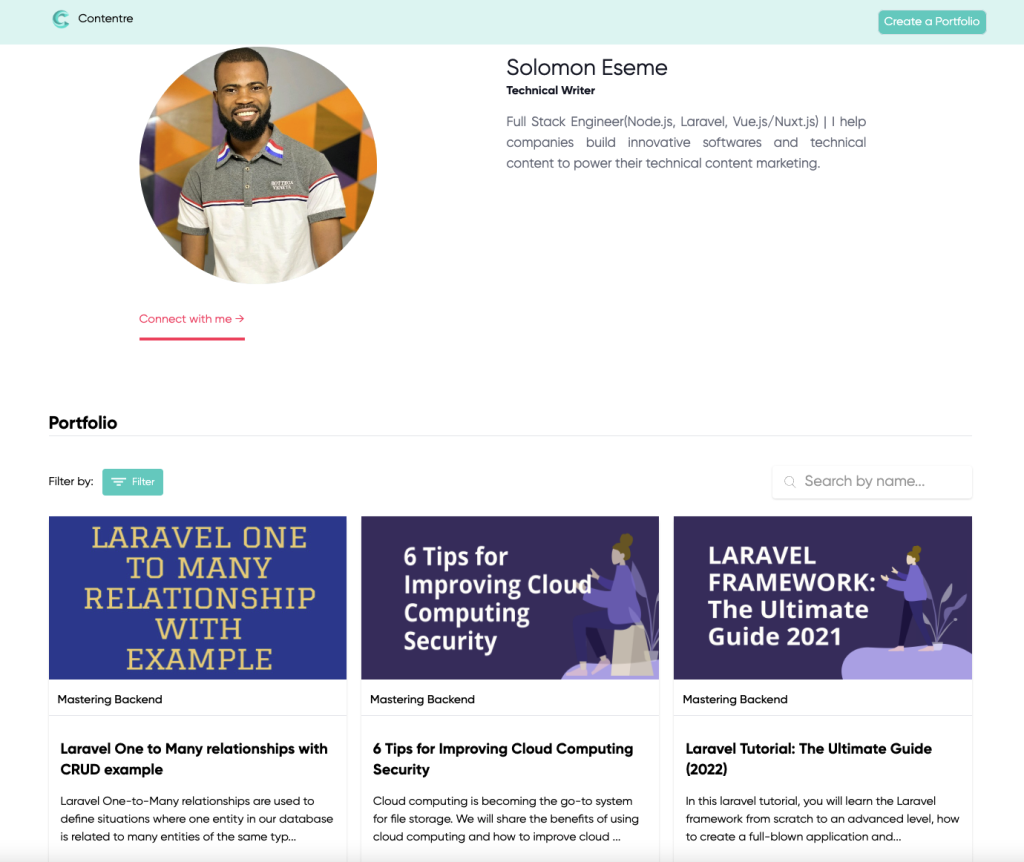
Now you know what a technical writing portfolio is and how important it is in growing your freelance writing career.
How do you generate content samples to add to your writing portfolio when you’ve never written any sample before as a newbie technical writer?
Here is a quick way to get you started by creating enough samples for your writing portfolio.
These platforms below give you opportunities to create and publish articles, and blogs for free. So you can use the content to create your technical writing portfolio.
Medium is an open writing platform where you can write and publish your stories for free. It is probably the best-known open-content platform. So feel free to register now and use the platform.
Clients also visit Medium to search for writers, so you have to make sure you give in your best shot. Getting good engagement stats on your articles and “claps,” from readers of your article may give anyone who wants to hire you the assurance to do so.
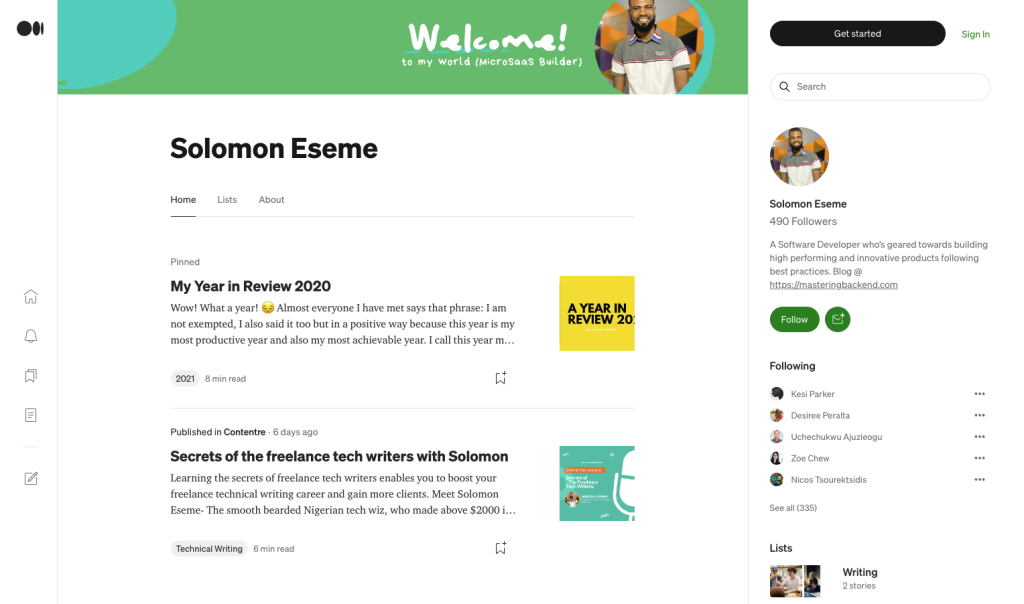
Tealfeed is also an open writing platform just like medium, where you can also write and publish your content for free all you have to do is sign up with them, and their interface is easy to navigate through even if you are just a beginner.
Guest Posting
Guest Posting is not a platform but it is a very popular option among freelance technical writers. It is also the best form of gathering relevant samples for your technical writing portfolio.
In Guest Posting, you search for tech companies who are willing to work with you and publish your content on their website as a newbie. This method if done properly exposes you to the real world of freelance technical writing.
You can start by pitching your article idea to Masteringbackend as they are constantly looking for technical writers.
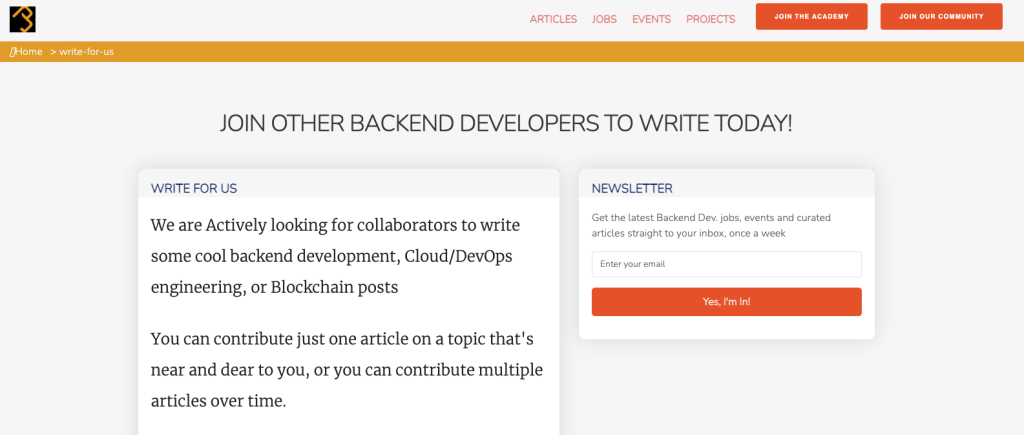
Now you should have published enough content samples using any of the above methods, we are ready to create our first technical writing portfolio.
Creating a Technical Writing Portfolio that stands out.
Creating a technical writing portfolio that would be able to bring trusted clients that are willing to pay you for technical writing gigs, will require you to put in quality time to its creation.
Taking the time out to select the best articles that you have written, that best showcase your talents, skills, and niche is the first thing you should do when creating your technical writing portfolio.
It’s also reasonable for your portfolio to highlight a particular niche in which you love to write. Then make it clear that you have real expertise in this niche even if you write in other niches.

You can use Contentre to create multiple portfolios in one place to streamline your portfolio to a particular niche or based on your client’s requiremen ts.
After selecting your best articles, then it’s time to add more personalized context for each article you selected by answering the questions below.
- Why are you proud of this piece of content?
- What challenges did you face during its creation?
- What skills (except for writing) did you have to employ to get the job done?
- What’s the impact of the content? What problems did it solve? e.t.c
- What tools did you use?
This personalized information added to each article makes your technical writing portfolio stand out because you’re deliberately giving context to each sample which will make your potential client further understand your skillset and how you can bring value to their business.
This is why we built Contentre , to help you CREATE multiple personalized portfolios that get you hired in one place and also to help grow your freelance technical writing career.
How to Build Your Writing Portfolio
We can create the technical writing portfolio in two ways.
- Using WordPress or Coding
Using Portfolio Building Platforms
Using wordpress or coding.
This method requires intensive knowledge of programming or a good knowledge of WordPress. It is also expensive and requires regular maintenance and checkups.
Here are the steps if this is a good option for you:
Choosing and registering a domain name
This is the first step to creating a writing portfolio for your technical writing.
If you already have a brand name you have set aside for your technical writing business, you can purchase a domain name around your brand name.
Here is a complete guide on how to acquire a domain name for your technical writing business.
Web hosting
Web hosting allows you to push your writing portfolio out there on the internet. Most domain name providers offer web hosting services so you can handle the two in one place all you have to do is subscribe for it.
Here is a complete guide on how to acquire a web hosting account for your technical writing business.
Using WordPress
If you have been able to get a domain name and hosting, then you can move on to creating your online writing portfolio with sites such as WordPress .
This site helps you build a brand as a technical writer by offering easy-to-use portfolio templates, saving you the stress of starting from scratch. All you have to do is follow the instructions displayed on your screen.
Designing the pages of your website
On your portfolio websites, there are pages that you need to pay attention to when designing your pages. these pages include:
- A homepage: The homepage comprises the details of what you stand for and different menu icons for navigating through your website
- About page: The about page shows off your knowledge, your expertise, and your “values”
- Contacts page: The contact page is where potential customers can find details to reach you like your contacts or email
- Portfolio page: This is where all your work samples are displayed
Below is a list of platforms that you can use to create your writing portfolio without spending time and money on web hosting, maintenance, and lastly without any knowledge of programming or WordPress.
Contentre is a platform that is dedicated to technical writers. It was developed by technical writers for technical writers. It provides the best resources and tools to help you grow your freelance technical writing career.
With Contentre , you can create multiple personalized technical writing portfolios. You can either customize your portfolio using the drag-and-drop to best suit your brand or choose from thousands of templates.
It helps you organize all your content, manage clients, share samples, and publish your work in various places, all in one place.
You can explore examples of popular technical writing portfolios built with Contentre.
Other commonly used portfolio sites include:
- Journoportfolio
Creating a technical writing portfolio from scratch is very important in your technical writing career and when searching for new technical writing clients.
So you need to put in your best and make sure that your portfolio reflects as perfectly as possible how professional you can be when delivering your technical writing services.
It should also be able to show the quality of your writing services by providing personalized context to each content sample while creating different portfolios for different niches or clients’ requirements.
We hope you take the time to follow the steps we have talked about so far, and if you do, we await your testimony as you land that technical writing gig.

Contentre helps technical writers stay organized and gain more clients. Grow your technical writing career in one place.
Now that you’re here, let me briefly recap the most important features Contentre can offer you:
- Organize your content in categories, topics, and tags
- Create and manage multiple clients
- Create and manage multiple personalized portfolios
- Get statistical analytics of your content revenue, top categories, and tags.
Try it now. It’s free
Founder Contentre.io | Grow your technical writing career in one place.
Related Posts

Top 10 Jobs In Technical Writing

Top 11 Types Of Technical Writing

HOW TO IDENTIFY GOOD TECHNICAL WRITING
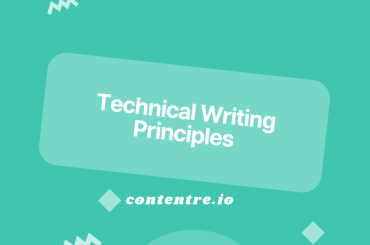
Comprehensive Guide to Technical Writing Principles
11 comments.
Pingback: Secrets of a freelance technical writer with John - Contentre Blog
Pingback: Ultimate Personal Branding For Freelance Writers (2022) - Contentre Blog
Pingback: What is Freelance Writing? The Ultimate Guide (2022) - Contentre Blog
Pingback: What is Technical Writing? The Complete Guide (2022) - Contentre Blog
Pingback: BTS 9: My technical writing journey from $15 to $800 - Contentre Blog
Pingback: How to Write a Good “How-to” Guide (2022) - Contentre Blog
Pingback: Top 5 Tips for Building a Good Technical Writing Portfolio - Contentre Blog
“This article is a gem for aspiring technical writers! It provides clear, actionable steps on creating a freelance technical writing portfolio from scratch.
Pingback: Technical Writing Jobs - Contentre Blog
Wow! As a newbie in technical writing. This article is one of the best few I have come across. It’s concise, informative and helpful. I haven’t been able to figure out how to create a professional portfolio for my business as a freelancer. And as a growing technical writer. I have learned a whole lot from the structure of the article alone.
“It was developed by technical writers for technical writers”.
Pingback: Types of Technical Writing: How to Choose? (2024) - Contentre Blog
Write A Comment Cancel Reply
Save my name, email, and website in this browser for the next time I comment.
Type above and press Enter to search. Press Esc to cancel.

How To Build a Technical Portfolio (And Why You Need One)

- Share article on Twitter
- Share article on Facebook
- Share article on LinkedIn
This article was written by our friends at Career Karma , just in time for the launch of our new and improved Career Paths , which now include Portfolio Projects.
Your technical portfolio is a key element in your search for a job as an engineer or developer. It’s an opportunity to showcase your skills through the projects you’ve worked on and shows prospective employers just what you’re capable of.
Whether you’re looking for a job in front-end or back-end development, or creating a full-stack developer technical portfolio , your portfolio should illustrate your interests and best abilities. It should be easy to read and navigate, and provide access to your launched projects. It should also allow a viewer to get familiar with your background and experience, including your tech stack.
In this article, we’ll dive into the essential ingredients for a good developer’s technical portfolio, including whether to use a template or build your portfolio from scratch, what to include in your bio, what types of projects to include, and more.
Building your portfolio website
Template vs. from scratch: how to decide.
If you have the time, consider building your portfolio from scratch. Not only will this give you some real-world practice, but it’ll also help you show off your technical skills. Watch the video below for a step-by-step breakdown of how to build a technical portfolio with HTML and CSS .
And if you want to make it even better, check out Part 2 to learn how to use JavaScript to make your portfolio interactive.
Or you could choose to go with a template. HTML5 UP and Template.net are great sites to obtain portfolio templates. You can download the code and edit or refactor it to suit you, your identity, and achievements. Note that if you are using one of these templates, you may have to give credit to the site and the creator in the footer of the portfolio.
The difference between template sites like HTML5 UP, versus other sites for pre-made portfolios, is that it is code based and not a drag and drop platform. You still have to use and edit code, which as a developer, is a good thing. Never use a drag and drop site for a technical portfolio, it is counterproductive and could hamper your chance of success.
Your domain name
Once you have polished the portfolio for how you’d like it to look for future employers, find and purchase a domain name. Your domain name should be the name you use on your resume, followed by a .dev, .me, or .com extension.
Important links
Some important links to include in your portfolio are appropriate social media accounts, such as LinkedIn and Twitter. Twitter has a large developer community so it is a great platform to build a network and stay up to date with industry happenings. It should be used as a tool for positive growth, so post mindfully and intentionally — your future employer is watching.
Other links include your github, which should display the projects you are proud of, and your resume. You can link a PDF version of it in your portfolio. Finally, a link to your email for a recruiter or hiring manager to contact you.
Navigating your portfolio
Include a sticky navigation bar on your site where a viewer can easily navigate to your “About,” “Projects,” “Other Contributions,” and “Contact” sections. A sticky navbar sticks to the top of the page across all links, no matter how far you scroll down the page.
Your bio: What to include
Your short biography should be in the “About” section of the portfolio. It should illustrate your past, present, and future aspirations. Tell a story about how you got into tech, what you are working on now, and what roles you are trying to land, in a positive light. Write about your current tech stack, and what technologies you are learning.
Projects: What to showcase
There several projects you want to showcase in your portfolio, including open source, individual, group, clone, and vertical.
Open Source
There is a wealth of open source contributing opportunities you can find online. You can contribute to anything from Firefox to npm, or join a hackathon to pick a lesser known project of your choosing.
Whether you are into gaming or climate tech, your individual project can be something that illustrates your personality or interests.
If you were fortunate enough to have worked in a cross-functional team with a successfully launched project, this project needs to be in your portfolio. Developing is very much a group effort, and employers are going to want to see that you have experience working on a project with different developers. If there was a stakeholder or client for this project, even better.
Product Clone
If you have a particular company in mind you would love to work for, clone their site! This is a super impressive way to get the hiring manager’s attention.
There are many vertices in software engineering, from testing to accessibility. If there is something that interests you, or that you excel at, build a project out of this skill. Verticals are also a good pairing to general software engineering roles for startups where employees need to wear multiple hats.
Project Descriptions
Below the link to your launched project, there should be a description explaining what the project is about. This can be two to three bullet points. The tech stack used on the project should be the first, followed by the product description. What problem does the product solve or what does this project do? You should also name two features you solely contributed to the project. Focus on “I” statements rather than “we.” The company isn’t looking to hire the team, they are looking to hire you. There should also be a github repo link to all the projects in your portfolio.
You can find other ideas on specific language projects on the Career Karma site for:
- JavaScript Projects
- Python Projects
- Java Projects
Other contributions
There are many other contributions you can share that will make you stand out. Technical writing is a highly in-demand skill, and you can show off your technical writing skills in other places other than in the Readmes or API docs. Medium and Dev.to are great places to contribute what you’ve learned or what you’d like to teach.
Other things to include in the “Other Contributions” section of your programming portfolio are package creations you may have created or video tutorials you may have done.
If you’re just getting started on your journey to becoming a web developer, Codecademy’s Career Paths can help get you there. Career Paths include a variety of Portfolio Projects that you can build and use in your job search. Find out more and start your journey here .
Related articles

What Soft Skills Are & How to Showcase Them
Soft skills don’t receive as much attention as hard skills, but they’re just as important. Learn how to showcase your soft skills during the hiring process.

The Most Important Soft Skill for Developers & How to Get Better at It
Try these problem-solving strategies the next time you’re feeling stuck.

The Interpersonal Skills That You Need in Tech Careers
Work is more than just contributing code — these people skills make you stand out.

6 Phrases That Make You a Better Communicator
Techniques and tips for your communication skill set.

8 Organizations Helping Girls & Women Build Careers in Tech
There’s a gender gap in tech — but it’s getting smaller thanks to organizations like these.

5 Ways to Stay Accountable to Your Learning Goals in 2024
Planning to learn to code in 2024? We’ve put together a list of 6 tips and resources to help you stay accountable to your coding goals this year.

30 Bite-Sized Goals for Learning to Code in 2024
It’s that time of year again — the time for making New Year’s resolutions! This year, let’s resolve to make resolutions we can keep.
Karen Rempel – New York Technical Writer
Bridging people and technology to help you succeed and delight your customers
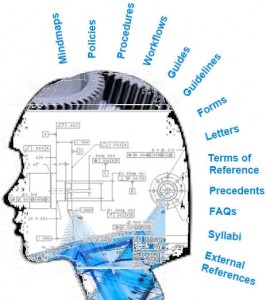

Portfolio Sample List
- Standard Operating Procedures – Sample 1 reduced costs and increased customer satisfaction and sales; Sample 2 helped build customer goodwill.
- Online Help and Quick Reference Guides – Sample 1 illustrates the use of DreamWeaver vs. MadCap Flare, Adobe InDesign vs. Microsoft Word; the documentation supported over 1,900 banking staff to use a new banking software system. Sample 2 integrated online help with a software implementation; the external software vendor bought this innovative methodology from my client.
- Software Documentation Suite – Online Help, User’s Guide, Installation Guide – The software’s documentation set of over 20,000 online help files and a comprehensive manual set is a prime factor in clients’ choice of this modeling tool.
- Online Knowledge Base – Uses Kentico CMS with Visio mindmaps and policy briefs to help staff understand and follow engineering licensing policy.
- Published How-To Book – This Canadian bestseller has helped over 40,000 people.
- Developer Documentation – From reviewing daily code and functional specifications to helping subscribers use Restful APIs to integrating context-sensitive help, I love working with developers and helping them with the documentation they need to do their job and serve their users.
RELATED TOPICS
- Content Strategist
- How to Become a Content Strategist
- Content Strategist Skills
- Content Strategist Interview Questions
- Content Strategy Manager Overview
- Content Strategy in UX
- Content Strategist Portfolio Examples
- Content Design Overview
- Content Designer
- Content Designer Skills
- Content Design Books
- Technical Documentation
- Knowledge Base Documentation
- Product Documentation
- User Documentation
- Process Documentation
- Process Documentation Templates
- Good Documentation Practices
- HR Document Management Best Practices
- Software Documentation Examples
- How to Test Documentation Usability
- Document Control Overview
- Document Control Process
- Document Control Procedures
- Document Control Numbering
- Document Version Control
- Document Lifecycle Management
- Document Management Software Workflow
- Document Management Practices
- Github Document Management
- HR Document Management
- Confluence Document Management
- What is a Document Management System?
- Document Control Software
- Product Documentation Software
- HR Document Management Software
- Knowledge Base Software
- Internal Knowledge Base Software
- API Documentation Software Tools
- Knowledge Management Tools
- Document Management Software
- What is Software Documentation?
- How to Write Software Documentation
- How to Write API Documentation
- Document Manager
- Documentation Manager
- Documentation Specialist
- Document Control Manager Salary
- Business Writing Overview
- Business Writing Principles
- Best Business Writing Examples
- Best Business Writing Skills
- Best Business Writing Tips
- Types of Business Writing
- Best Business Writing Books
- What is Grant Writing?
- Grant Writing Process
- Grant Writing Templates
- Grant Writing Examples
- Grant Proposal Budget Template
- How to Write a Grant Proposal
- How to Write a Grant Proposal Cover Letter
- Grant Writing Books
- Grant Writer Role
- How to Become a Grant Writer
- Grant Writer Salary
- Grant Writer Resume
- Grant Writing Skills
- Grant Writer LinkedIn Profile
- Grant Writer Interview Questions
- Proposal Writing Overview
- How to Become a Proposal Writer
- Proposal Writer Role
- Proposal Writer Career Path
- RFP Proposal Writer
- Freelance Proposal Writer
- Remote Proposal Writer
- Government Proposal Writer
- Proposal Writer Salary
- Proposal Writer Job Description Example
- Proposal Writer Interview Questions
- How to Write a Proposal
- Proposal Writer LinkedIn Profile
- Business Proposal Examples
- UX Writing Overview
- Information Architecture
- Information Architecture vs Sitemap
- UX Writing Books
- UX Writing Examples
- UX Writer Overview
- Freelance UX Writer Overview
- UX Writer Career Path
- How to Become a UX Writer
- Google UX Writer
- UX Writer Interview Questions
- Google UX Writer Interview Questions
- UX Writer vs Copywriter
- UX Writer vs Technical Writer
- UX Writer Skills
- UX Writer Salary
- UX Writer Portfolio Examples
- UX Writer LinkedIn Profile
- UX Writer Cover Letter
- Technical Writing Overview
- Types of Technical Writing
- Technical Writing Examples
- Freelance Technical Writing
- Technical Writer Style Guide Examples
- Technical Writing Jobs
- Subject Matter Expert
- Document Development Lifecycle
- Darwin Information Typing Architecture
- Technical Writer Career Path
- How to Become a Technical Writer
- Technical Writer Education Requirements
- English Teacher to Technical Writer
- Software Engineer to Technical Writer
- Technical Writer Salary
- Technical Writer Interview Questions
- Google Technical Writer Interview Questions
- Technical Writer Resume
- Technical Writer Cover Letter
- Technical Writer LinkedIn Profile
- Technical Writer Portfolio
- Senior Technical Writer Salary
- Senior Technical Writer Job Description
- Knowledge Management Overview
- Knowledge Management System
- Knowledge Base Examples
- Knowledge Manager Overview
- Knowledge Manager Resume
- Knowledge Manager Skills
- Knowledge Manager Job Description
- Knowledge Manager Salary
- Knowledge Manager LinkedIn Profile
- Medical Writing Overview
- How to Become a Medical Writer
- Entry-Level Medical Writer
- Freelance Medical Writer
- Medical Writer Resume
- Medical Writer Interview Questions
- Medical Writer Salary
- Senior Medical Writer Salary
- Technical Writer Intern Do
- Entry-level Technical Writer
- Technical Writer
- Senior Technical Writer
- Technical Writer Editor
- Remote Technical Writer
- Freelance Technical Writer
- Software Technical Writer
- Pharmaceutical Technical Writer
- Google Technical Writer
- LinkedIn Technical Writer
- Apple Technical Writer
- Oracle Technical Writer
- Salesforce Technical Writer
- Amazon Technical Writer
- Technical Writing Certification Courses
- Certified Technical Writer
- UX Writer Certification
- Grant Writer Certification
- Proposal Writer Certification
- Business Writing Classes Online
- Business Writing Courses
- Grant Writing Classes Online
- Grant Writing Degree
Home › Career › What Does a Content Strategist Do? › Best Content Strategist Portfolio Examples
Best Content Strategist Portfolio Examples
TABLE OF CONTENTS
Are you looking for content strategist portfolio ideas?
Perhaps you’re a newbie content strategist looking for your first job. You want to create a reputation for yourself in the field of content strategy, which includes building an excellent portfolio.
Whether you’re beginning from zero or revitalizing an established portfolio, there are a few ground principles to keep in mind. In this blog post, we’ll walk you through 10 content strategy portfolio best practices, along with fantastic portfolio examples from across the web.
But first, let’s build a content strategist portfolio, as well as the function it serves and some resources for creating one:
- What is a content strategist portfolio, and why do you need one?
- How to build an outstanding content strategist portfolio?
Let’s jump in.
What is a Content Strategist Portfolio?
A content strategist portfolio showcase relevant work that you’ve done related to implementing strategic decisions around content including SEO frameworks, internal linking efforts, information architecture, and more.
When developing a fantastic content strategist portfolio, it’s critical to understand what you want your portfolio to do. What information should you include in your portfolio? When visitors visit your portfolio, what do you want them to understand about you and your work?
It should introduce you as a content strategist and offer the audience an idea of how you operate. Of course, you should pack all of these insights in an easy-to-read, user-friendly format.
How to Create an Outstanding Content Strategist Portfolio?
Because a portfolio is all about showing your work as a content strategist, it’s evident that you need to have some experience to have work to highlight in the first place.
However, don’t be concerned if you lack industry experience.
Without prior content strategist experience, it is possible to establish a great portfolio, break into the industry, and thrive. Taking a course is a fantastic place to start.
In addition, you should ensure that your portfolio fits the following criteria:
- A unique introduction is included.
- The clickable email address is plainly visible (so that the viewers of your portfolio or visitors of your website don’t lose any time to find your email and reach you).
- Demonstrates reflexivity – demonstrates your capacity to reflect on and learn content in a user-friendly style.
- Excellent content – demonstrates that you understand what a fantastic, polished result in terms of content looks like.
- Request testimonials – ask your customers to write testimonials about you.
Top Content Strategist Portfolio Examples
Here are our top five content strategist portfolio examples. We’ll go through each one in-depth to ensure you understand the background and what you can take away from it. Let’s get started!
1. Emily Galeano Delivers Simplicity
Who Is Emily Galeano?
Emily is a multilingual UX Content Strategist with a psychology and marketing degree and a love of UI copy, UX, and branding. She is self-motivated, creative, and analytical. She appreciates problem-solving through innovative and data-driven methods.
Spending time with her dog, powerlifting, producing art, shooting photography, reading, writing, discovering the best craft beers and coffee, microbrewing, collecting records, camping, playing board games and my Nintendo Switch, and cheering for the Braves are among her interests.
What Makes Emily’s Content Strategist Portfolio so Great?
Emily presents short and precise, easily understandable, and to the point content in her portfolio. In the upper side of each example, she presents the type if it is an article, UX writing, UX content strategy, guide, or marketing campaign. At the bottom of each example, the heading is mentioned.
What Can We Learn From Emily?
People are much busier and have a short attention span than ever. Therefore, it’s better to be results-oriented and provide concise, goal-oriented information than to offer them tons of information.
Key Takeaway
Use your portfolio to show how you provide value to the business. Set business goals and success indicators for each case study, and incorporate data and actual outcomes when feasible.
View Emily’s full portfolio website
2. Kim Gillick Delivers Quality Business Cases
Who Is Kim Gillick?
Kim helps companies align their content initiatives with their business objectives.
She has ten years of experience in digital marketing, focusing on content strategy and copywriting.
She primarily works with B2B, technology, consulting companies, and government agencies of all kinds.
Many of her previous and present clients include multinational corporations such as IPL, Enterprise Ireland, and Stack Overflow.
She assists clients in better understanding their users and optimizing the user experience for conversions.
What Makes Kim’s Content Strategist Portfolio so Great?
Kim represents the information visually. Kim creates content work for different business areas such as advertising agencies, tech startups, consulting companies, Boutique Guesthouse, Productivity App, Government Agency.
What Can We Learn From Kim?
Kim does an excellent job of demonstrating how she works in a business atmosphere. This is critical if you want to make a living off of content strategy, but it’s a technique that many content strategists overlook. While it’s true that you’re there to advocate for the user, it’s equally crucial to remember that businesses have their objectives to achieve.
You’ll get some big additional points if you can explain how your work adds value to the business. This will be simple if you have project-related data to share, but what if you don’t have any tangible metrics to offer?
Even if you don’t have any data, you may position your work from a business perspective. Set a business or product objective at the start of the case study, as Kim did. What do you intend to achieve with your work? This is distinct from the user’s purpose, although the two should work hand in hand.
Use your portfolio to show how you provide value to the business. Set business goals and performance indicators for each case study, and incorporate data and actual outcomes when feasible.
View Kim’s full portfolio website
3. Jessie Beck Delivers Professionalism
Who Is Jessie Beck?
Jessie is a content strategist and SEO expert specializing in digital content for tech, travel, and outdoor industries. During the previous seven years, she has worked with companies such as AFAR, Facebook, Asana, Tortuga Backpacks, Carryology, and Go Overseas.
What Makes Jessie’s Content Strategist Portfolio so Great?
Jessie’s portfolio and projects look amazingly professional. Viewers find another outstanding example of storytelling in Jessie Beck’s portfolio. She offers her design work in the form of case studies, which show her approach from beginning to end. But it’s Jessie’s use of visuals to complement the narrative she’s weaving that truly shines out in her portfolio.
Each point in her case study is accompanied by a visual element, such as a virtual wall of Post-it notes, a survey form emailed to research participants, or early-stage prototypes.
What Can We Learn From Jessie?
Your content strategist portfolio should both show and tell. Support each case study, like Jessie did, with powerful visuals which are actual items from your project, not simply pictures.
Document your workflow every time you work on a new design project:
- Capture pictures of user research surveys you send out.
- Take images of your wall covered in sticky notes after a long brainstorming session.
- Please keep track of your wireframes as they move from low to high quality.
Bring each project’s story to life using visual artifacts rather than simply telling it. For example, include a snapshot or screenshot of how it appeared in action for each phase in your case study.
View Jessie’s full portfolio website
4. Rebekah Wolf Delivers Simplicity in Content
Who Is Rebekah Wolf?
Rebekah is a Seattle-based writer, editor, and content strategist. For two years, she worked as the sole content creator for Pagliacci Pizza and Macrina Bakery. She was in charge of everything from social media strategy to website content to package copy and print newsletters.
She led content strategy at Black Pixel and started writing user interface content for mobile apps.
She is now a user experience content designer for Microsoft’s Cloud and artificial intelligence (AI) design team.
She likes looking for the story in everything, working with designers and engineers, and utilizing words to create valuable and pleasant experiences for everyone.
What Makes Rebekah’s Content Strategist Portfolio so Great?
Rebekah generally works presenting software projects’ content. Rebekah presents the projects in an easy-to-understand way by displaying the screenshots of the graphical user interfaces (GUI) of the software that she works on and then with text explaining the details of the screenshot.
What Can We Learn From Rebekah?
Follow Rebekah’s lead and place your process front and center when exhibiting your content strategy work. Because Rebekah is telling a logical story, she doesn’t display the completed product until the very end of each case study.
Begin at the beginning of each case study and walk the viewer through the essential processes that brought you to the ultimate answer. It’s great to share screenshots of a gorgeous finished product, but make sure you’ve thoroughly documented your process beforehand.
Display your process, not just the completed product. Write about the approaches you utilized, what you learned along the route, the obstacles you encountered, and how you handled specific difficulties. Each case study should tell a whole, logical story.
View Rebekah’s full portfolio website
5. Josh Tong Helps Teams Create User-Friendly Digital Experiences
Who is Josh Tong?
Josh is a content strategist who works with teams to develop user-friendly digital experiences, particularly in large, complex organizations.
He is currently a lead content strategist at MERGE, a full-service digital agency. Before joining MERGE, he worked as a senior content strategist at IREX, global development, and education NGO. He led the organization’s global content strategy. He formerly led a digital strategy for Catholic Relief Services’ overseas operations. He was a founding member of the organization’s content strategy team.
He has also edited manuscripts for publishing houses and assisted in developing digital resources for research libraries. He has been creating websites since the 1990s.
What Makes Josh’s Content Strategist Portfolio so Great?
John’s portfolio truly gets to the heart of what it means to be a content strategist: going through a process to solve a user problem. John doesn’t simply show the completed product; he goes into great depth on the methods and processes he used to get there.
Each project is presented as a case study, which tells us right away that we’re in for a lot more than simply eye candy.
What Can We Learn From Josh?
When it comes to your portfolio, follow Josh’s lead and offer a significant introduction. Please keep it simple yet eye-catching on the front page. Then, go into additional information in a separate “Work” area. Aside from writing a compelling “About” area, attempt to incorporate some individuality into the content strategy.
Josh is an experienced content strategist with various real-world projects in his portfolio. Just like Josh, be upfront about the fact that these are unsolicited projects-a simple disclaimer is all that is required.
Another important takeaway from Josh’s portfolio is the importance of blogging. His work isn’t limited to his portfolio website; he also publishes her case studies.
There are several methods to share your process, so don’t hesitate to explore multiple approaches.
Within seconds of coming to your portfolio, the viewer should know exactly who you are and what you do. Create a great headline that summarizes the most crucial information.
Demonstrate your initiative as a planner, designer, creator, editor, and publisher of relevant content based on users’ needs. Frame the problem, document your process, and tell a good story.
View Josh’s full portfolio website
Final Thoughts
If you’re looking to create documentation for your portfolio, get a hands-on introduction to content strategy and build your portfolio with a Technical Writer HQ certification . If you are interested in planning, designing, creating, editing, and publishing relevant content based on a company’s business objectives and users’ needs, you can build a career as a content strategist. The first step is to showcase your work and get noticed. Good luck creating your content strategist portfolio.
We offer a wide variety of programs and courses built on adaptive curriculum and led by leading industry experts.
- Work on projects in a collaborative setting
- Take advantage of our flexible plans and community
- Get access to experts, templates, and exclusive events
Become a Certified Technical Writer. Professionals finish the training with a full understanding of how to guide technical writer projects using documentation foundations, how to lead writing teams, and more.
Become a Certified UX Writer. You'll learn how to excel on the job with writing microcopy, content design, and creating conversation chatbots.
Become a Certified Grant Writer. In this course, we teach the fundamentals of grant writing, how to create great grant proposals, and how to stand out in the recruiting process to land grant writing jobs.
Please check your email for a confirmation message shortly.
Join 5000+ Technical Writers
Get our #1 industry rated weekly technical writing reads newsletter.
Your syllabus has been sent to your email
Filter by Keywords
10 Technical Writing Tips To Help You Breakdown Any Complex Topic For Your Audience
Sudarshan Somanathan
Head of Content
June 21, 2024
As a technical writer, your main job is simplifying complex topics for everyday readers.
You must be able to present technical and complex concepts in a simple and understandable language.
We get it. Technical writing is challenging. It requires strong writing, editing, and formatting skills and needs to balance accuracy and simplicity.
This technical writing guide explores how to create more effective documents and improve your technical writing skills, as well as the common mistakes to avoid.
As a technical writer, use these best practices to ensure your technical documents are accurate, concise, and easy to comprehend.
What is Technical Writing?
1. know your audience, 2. create an outline, 3. research your topic with the 5w1h approach, 4. create content tailored to user personas, 5. organize your information effectively, 6. have a style guide for consistency, 7. know the technical documentation essentials, 8. write for clarity and conciseness, 9. include multimedia elements, 10. use relevant examples, 1. jargon and complex language, 2. neglecting proper formatting, 3. being vague and ambiguous, 4. ignoring your audience’s needs, 5. treating the user experience as an afterthought.
Technical writing makes complex information, ideas, processes, and instructions accessible to everyone, regardless of their expertise. When you start creating reader-centric technical documentation, your company/product stands a much better chance of acquiring and retaining customers.
Technical documents are used in different technical fields for:
- User guides
- Standard operating procedures
- Project documentation
- Software documentation
- Training materials
- Technical reports
- Scientific paper
- API Documentation
If you’re looking to navigate the complexities of technical writing with confidence, here are the technical writing tips to make it a breeze.
10 Technical Writing Tips to Improve Your Writing
The first step to writing technical documents isn’t to actually write. Instead, take some time to understand who your audience is—to address their specific needs in your writing.
Even the most experienced technical writer doesn’t skip this step of building a human connection by addressing the key technical topics in your documents.
So, how can you understand your audience? Here are some questions you can start with:
- What is their role or job function? Are they end-users, technicians, managers, or another group?
- What is their technical background and level of expertise with the subject matter?
- In what context will they use the document—to learn, troubleshoot, or make decisions?
- What specific tasks or questions will they have?
- What type of tone and language would be appropriate?
Let’s understand it with an example.
You’re using a help authoring tool to write a user guide for a new software application.
Target audience: First-time users with basic computer skills who need guidance on using your app.
To meet their needs, your technical writing document should:
- Have step-by-step instructions for all the key tasks that they will perform
- Be written in clear, concise language
- Define technical terms and abbreviations
- Include screenshots or diagrams to guide them visually through the next steps
When you tailor your message to their needs and knowledge level, you can create technical documents that make it easy for them to use your product.
Conversely, effective technical writing for admin users will require more advanced language.
Once you have determined the audience’s needs, create an outline with the main topics and subheadings you want to cover. This will give you a foundational structure for your technical documentation and make the writing process smoother.
When you are writing an outline, think about:
- Key questions: What are some key questions that they want answers to?
- Problem-solving: What problem are you helping them solve?
- Purpose: What will they use your technical document for?
Use these insights to shape the main sections of your outline, which you then break into smaller topics or subsections, each focusing on a specific audience need or goal.
ClickUp Whiteboards are helpful for brainstorming the outline, jotting down ideas, adding images and drawings, and creating related task links.

For example, for a user guide for a new software application, you’ll have to guide users through installing, setting up, and using the software’s basic features. The outline will include:
- Introduction
- Purpose of the software
- Overview of features
- System Requirements
- Hardware requirements
- Software prerequisites
- Installation Steps
- Downloading the software
- Step-by-step installation process
- Getting Started
- Initial setup
- Creating an account
- Basic Features
- Overview of the main dashboard
- How to navigate the software
- Common tasks and how to perform them
- Real-world examples
- Common Error Messages and How to Resolve Them
- List of common issues
- Step-by-step troubleshooting guide
Good technical writing starts with creating a detailed outline covering necessary information logically and comprehensively to make your document useful to the reader.
Engage your team sessions using different ideation techniques , such as whiteboards, mind maps, prototyping, and storyboarding.
The best technical writers use the 5W1H (Who, What, When, Where, Why, and How) framework to cover the essential aspects of the written content to ensure the document is relevant to your audience in the technical field.
| Consider their expertise, role, and how they’ll use your document. Tailoring your content to them will make your writing more effective and valuable. : Are they end-users needing step-by-step guides, or are they developers requiring detailed API documentation? |
| Decide on the main goal, specific topics, and the level of detail needed. This helps you create a focused and comprehensive piece. : Is the document meant to explain a new software feature, or is it a troubleshooting guide for common issues? |
| Set a timeline and milestones to keep everyone on track and meet critical deadlines. : When will the new feature be released? When should the documentation be ready? |
| Choose reliable and relevant sources to ensure your technical document is accurate and credible. : Use internal engineering documents, credible online sources, or interviews with subject matter experts. |
| Think about how your document will solve problems, improve processes, or increase knowledge for your audience. : Will it help users reduce downtime, increase productivity, or better understand a complex system? |
| Pick the best format based on your audience’s needs and preferences, like a user manual, technical report, or online help guide. Whatever the format, simplify the language in the art form to ensure the information is easily understandable. : Should you use step-by-step instructions, include visual aids, or provide detailed explanations? |
Based on your intended audience, you can adapt your writing in the following ways:
- Choose the most appropriate tone and language
- Determine the right level of technical detail to include
- Anticipate and address their questions or concerns
- Structure your document in a way that’s easy to navigate and understand
If you’re writing a user guide for end users and administrators, here is how your approach will differ:
| Language | Simple, non-technical | More technical |
| Tone | Casual, friendly | Formal |
| Instructions | Step-by-step for key tasks | Detailed for installation, configuration, troubleshooting |
| Visuals | Plenty of screenshots and visual aids | It may include fewer visuals |
| Focus | Benefits for daily work | Smooth operation across the organization |
| Knowledge Level | Basic | Higher IT knowledge |
| Covered Topics | Software benefits | Installation, configuration, troubleshooting, security |
| Users Addressed | End-users | Administrators, IT personnel |
At this stage, consider creating a scope of work document detailing the work that needs to be done—including the objectives, tasks, dependencies, and any other relevant information required to guide the project to successful completion.
ClickUp Brain , ClickUp’s built-in AI writing tool , helps you create technical documentation and work scope within minutes. Use the drop-down menus with suggestions to finish your sentences, change color schemes, update typography, add meeting notes and summaries, and get the document ready in a fraction of the time.
At this stage, ask yourself, “How will my readers be able to find what they’re looking for quickly and easily?”
The crux is to organize your information logically and make it scannable.
Here’s how to do so:
- Use headers and sub-headers to help readers quickly locate the information they need
- Incorporate lists and bullet points to highlight key points and make the text easier to scan
- Include images, diagrams, tables, and other multimedia elements to illustrate complex concepts and make your document more engaging
- Use consistent formatting—font styles, sizes, colors, and spacing throughout the document
- Arrange the information logically, starting from the most basic concepts and gradually moving to more advanced topics
Using ClickUp Docs to enhance your technical documentation
For your product development process, which could involve multiple team members, consider using ClickUp Docs to define your goals and audience, outline the product requirements, add user research, and ensure consistency across the board.
Use Docs to create, edit, manage technical communication, and collaborate with your team in real-time. Everyone can add comments; project managers can tag team members and assign tasks within ClickUp Docs.
To present your information effectively, you can add sections, visuals, and tables to make your technical documentation more engaging.
ClickUp Docs offers various formatting options, including header styles, color choices, font options, and paragraph spacing, to break up monotony and enhance your document’s readability.
Pro tip 💡: Use technical documentation templates or engineering templates to outline your product’s features and uses, present details and features, and document the product knowledge for current and future employees.
When multiple people work on the technical document, inconsistencies and errors can creep in if their styles don’t align.
A style guide is like a unifying force maintaining the same standard across technical documents.
Why a style guide is essential:
- Ensures consistency: It keeps the writing style uniform across all documents, which is crucial for readability and professionalism
- Saves time: With predefined guidelines, writers spend less time deciding how to format content, allowing them to focus more on the actual writing
- Reduces errors: A style guide helps minimize inconsistencies and errors, ensuring all documents meet the same quality standards
For example, the ClickUp Process and Procedures Template allows you to document and manage processes in one place. Create step-by-step instructions for repeatable tasks to standardize your team’s process and procedure workflows.

Brownie points for using ClickUp’s Project Management Platform to assign tasks to your team members, let them add technical information in pre-built templates, and track task progress on a single platform.
Read more: How to write a report: from conceptualization to completion
Get the basics right, regardless of the type of technical document you’re creating.
Stick to the facts
In all technical documents, present information objectively. Avoid emotional language or personal opinions. Subjective opinions can bias your writing and undermine your credibility.
- For example, instead of saying, ‘You’ll love this feature!’, say, ‘This feature can reduce your data processing time by up to 40%.’
Avoid vague language
Use precise language to ensure your readers know exactly what to expect and how to follow your instructions.
- Instead of saying, ‘Go to the next step,’ provide specific details: ‘Click on the “Next” button.’
Use active voice
Active voice makes your writing direct and engaging.
- Instead of writing, “The software installation will need to be updated every month,” write, “You will need to update the software every month.”
Use ClickUp’s technical specifications generator to generate ideas, processes, and frameworks for your product and process documentation.
If you’re a part of the software team responsible for documenting API, architecture, data flow, and new modules, use ClickUp Brain’s technical writing tool to create comprehensive technical documents—to reduce misunderstandings, improve collaboration, and accelerate the development process.
The AI writing assistant checks for spelling and grammar, rewrites chunks of text, and summarizes lengthy paragraphs for added clarity and precision.
When writing content, in general, it’s good to be clear and concise to drive your point. But in technical writing, it’s absolutely necessary .
Communicating complex ideas helps your audience quickly grasp key points without getting lost or confused.
So, how can you make your technical writing clearer and more concise?
By simplifying your language.
| Immutable | Unchangeable | ‘Use immutable data structures’ → ‘Use unchangeable data structures’ |
| Refactor | Improve or reorganize | ‘Refactor the codebase for better maintenance’ → ‘Improve the codebase for better maintenance’ |
| Middleware | Intermediate Software or Connector | ‘Implement authentication middleware’ → ‘Use intermediate software for authentication’ |
Remember that effective technical documentation involves iterations and fine-tuning. Plan feedback sessions with your team, who may point out the features you may have missed.
ClickUp Forms will help you collect feedback from designated team members in a structured format. The best part is that it is integrated into ClickUp’s platform, which makes it easier to stay on top of your work.
Break lengthy paragraphs and text using visually engaging elements like diagrams, images, or videos. They make it easier to illustrate your point.
For example, add screenshots to a user guide to show people exactly where to click and what they should see at each step.
Remember to add high-quality, relevant, and clear multimedia elements. Use captions to explain what each image shows and how it relates to the text around it.
ClickUp’s Integration with tools like Figma, GitHub, Zoom, YouTube, and other multimedia tools makes adding visual elements to support your content within the ClickUp Workspace easier.
You want to make it easy for readers to gauge what you’re saying in an engaging format.
Show, don’t tell.
This applies to technical writing as well.
Include examples to make your technical writing engaging, user-friendly, and accessible. Examples help the reader quickly grasp complex concepts by showing how they work.

To add value, choose examples that highlight key features, demonstrate essential use cases, or walk through common workflows step-by-step. Use detailed and specific examples to provide clear insights into the subject.
Pro Tip💡: Code snippets, screenshots, and sample outputs are all great examples in technical documents.
Read more: 15 Best case study templates to use in ClickUp and Word
Improve Your Technical Writing Skills: Common Mistakes to Avoid
Your technical document should be approachable to clients and readers from all backgrounds.
How to avoid this mistake:
✅ Use technical writing tools like ClickUp Brain to simplify your writing
✅ Provide examples to illustrate complex concepts
✅ Have a non-expert review your writing for clarity
✅Add explanations to technical terms
Large blocks of unbroken text, lack of headings, and poor visual organization make technical content hard to navigate and digest.
✅ Break up long paragraphs into shorter, more manageable chunks
✅ Use descriptive headings and subheadings to organize content
✅ Incorporate lists, text boxes, and bullet points to highlight key information
✅ Ensure there is sufficient white space to give the document visual breathing room
Vague and ambiguous language can confuse your readers.
✅ Be precise in your language
✅ Avoid phrases like ‘maybe,’ ‘generally,’ or ‘a bit’
✅ Define all acronyms and abbreviations used
✅ Provide concrete examples to illustrate your points
✅ Use active voice and direct instructions
Failing to think about your audience’s needs will make your documents unclear.
✅ Understand your audience’s background, goals, and pain points
✅ Tailor your content to the audience’s level of expertise
✅ Focus on the information that is most relevant and useful to your readers
✅ Gather user feedback and iterate based on their input
When you focus on writing without considering the user experience, your documents can become confusing and fail to serve their purpose.
✅ Structure your content logically and intuitively
✅ Provide navigation aids like tables of contents and cross-references
✅ Include quick reference guides and cheat sheets for easy access to key information
✅ Make your content searchable and easily skimmable with clear headings and formatting
✅ Test your documents with real users to identify and fix usability issues
Ready to Level Up Your Technical Documentation with ClickUp?
Imagine if all your technical documents—SOPs, user manuals, how-to guides, and use cases—contributed to your company’s or product’s success.
What if we told you this was very much possible: with a mix of clarity in your content and software like ClickUp, helping you level up your technical writing?
To do this, start by implementing our technical writing tips. Then, use ClickUp to brainstorm the outline, gather feedback from your colleagues, integrate multi-media integrations, and leverage ClickUp Brain as your AI writing assistant.
Start creating technical documentation that your users will love, by signing up on ClickUp for free .
Questions? Comments? Visit our Help Center for support.
Receive the latest WriteClick Newsletter updates.
Thanks for subscribing to our blog!
Please enter a valid email
- Free training & 24-hour support
- Serious about security & privacy
- 99.99% uptime the last 12 months
Technical Writing 101: Definition, Examples, and How to Become One
A complete guide to everything you need to know about technical writing and technical writers

Technical writing is a form of writing on a specific topic that requires guidance, instruction, or explanation. This writing style serves a unique purpose and therefore has very different qualities than other types of writing, such as creative writing, academic writing, or business writing.
Because of this, technical writing is vital to a wide range of businesses and industries. Without it, complex topics and certain procedures would be difficult—or impossible—to understand or accomplish.
To recognize the important role technical writing plays in your own business or sector, it’s important to first understand what technical writing is, along with its unique characteristics.
In this guide, we cover all there is to know about technical writing, so you’ll be an expert in no time
What is technical writing?
Technical writing is a writing discipline that involves communicating complex information to those who need it to carry out a specific task or achieve a certain goal. Because of this, technical writing is often defined as “simplifying the complex.”
Get it right with a freelance writer
From proofreading to speech writing, writers on Fiverr have got you down to the last edit.
It’s a subcategory of technical communication and is primarily used in technical and operational disciplines, such as digital technologies, engineering, science, aeronautics, robotics, finance, medical, electronics, environmental regulations, and biotechnology.
Find a technical writer for hire
Components of technical writing.
While many people associate technical writing with creating computer or software manuals, it can be used in any industry that communicates complicated ideas, theories, practices, or procedures.
Since there have been written languages, there has been technical writing. Technical communication and technical writing as careers originate around the time of World War I, when technological advances in the military, industry, and telecommunications began to accelerate.
Technical writing differs from other types of writing in several ways:
Clear: Technical writing conveys information clearly and concisely, leaving little room for interpretation. The language is straightforward and succinct.
Straightforward: Facts are presented in a direct and to-the-point manner.
Precise: Technical writing uses specific terminology to precisely describe objects and processes.
Easy to understand: Technical writers use simple, understandable words and avoid complex terminology.
Denotative: Technical writing emphasizes literal definitions. By doing so, you avoid misunderstandings caused by the many different connotations of words.
Detailed: Technical writing leaves no room for interpretation. For example, a textbook provides the most comprehensive and factual overview of a topic of technical writing.
Very structured: It needs to have a clear structure so readers can follow along. Readers rely on technical documents for step-by-step instructions.
Easy to skim: Documents are written with 'skimability' in mind, so audiences can simply scan the text to get the information they need. There is often a table of contents, index, and relevant, descriptive headings.
Problem-solving: Every technical document is written to solve problems. In these texts, readers learn how to accomplish certain tasks or obtain technical information.
Technical writing aims to communicate complicated information to readers in a way they can comprehend and use, regardless of their prior expertise.
Technical writers produce technical writing. They explain technical information to another individual or audience as clearly and effectively as possible. These writers also leverage AI content marketing tools to improve accuracy and speed up the writing process.
What does a technical writer do?
Technical writers are talented wordsmiths who often create product manuals, how-to guides, online wiki sections, journal articles, press releases, and other material that simplifies and explains technical information.
These writers usually have a background in their subject matter, whether acquired academically or on the job. This subject matter often includes science, medical, engineering, software, manufacturing, or other technical sectors.
They build on this foundation to clarify difficulties and get their readers—which often include developers, project workgroups, engineers, and consumers—on the same page.
Overall, a technical writer’s mission is to make procedures simple to grasp and products easy to use.
A technical writer is responsible for a number of tasks, including:
Gathering technical information on their company's or department's line of business
Plan the creation of technical documents according to the needs of the company
Sort information according to its relevance and value
Create and edit the necessary documentation
Make copies of all technical documents and enter them into the database for data security
Maintain a comprehensive glossary and library of technical words and records
Along with this, certain technical writers may also have other responsibilities or duties within their specialty area.
Medical writers, for example, frequently publish medicine-related material and product reviews in medical journals.
If you work as a Google technical writer, on the other hand, you might write content on how users can embed YouTube videos.
Regardless of the field a technical writer works in, their role will involve two key duties: subject matter research and technical document planning.
What is a technical writer salary?
The U.S. Bureau of Labor Statistics (BLS) reported the average wage for technical writers, at $81,470 per year in 2021. The lowest 10% earned $48.890 on average, and the highest 10% earned over $125,010.
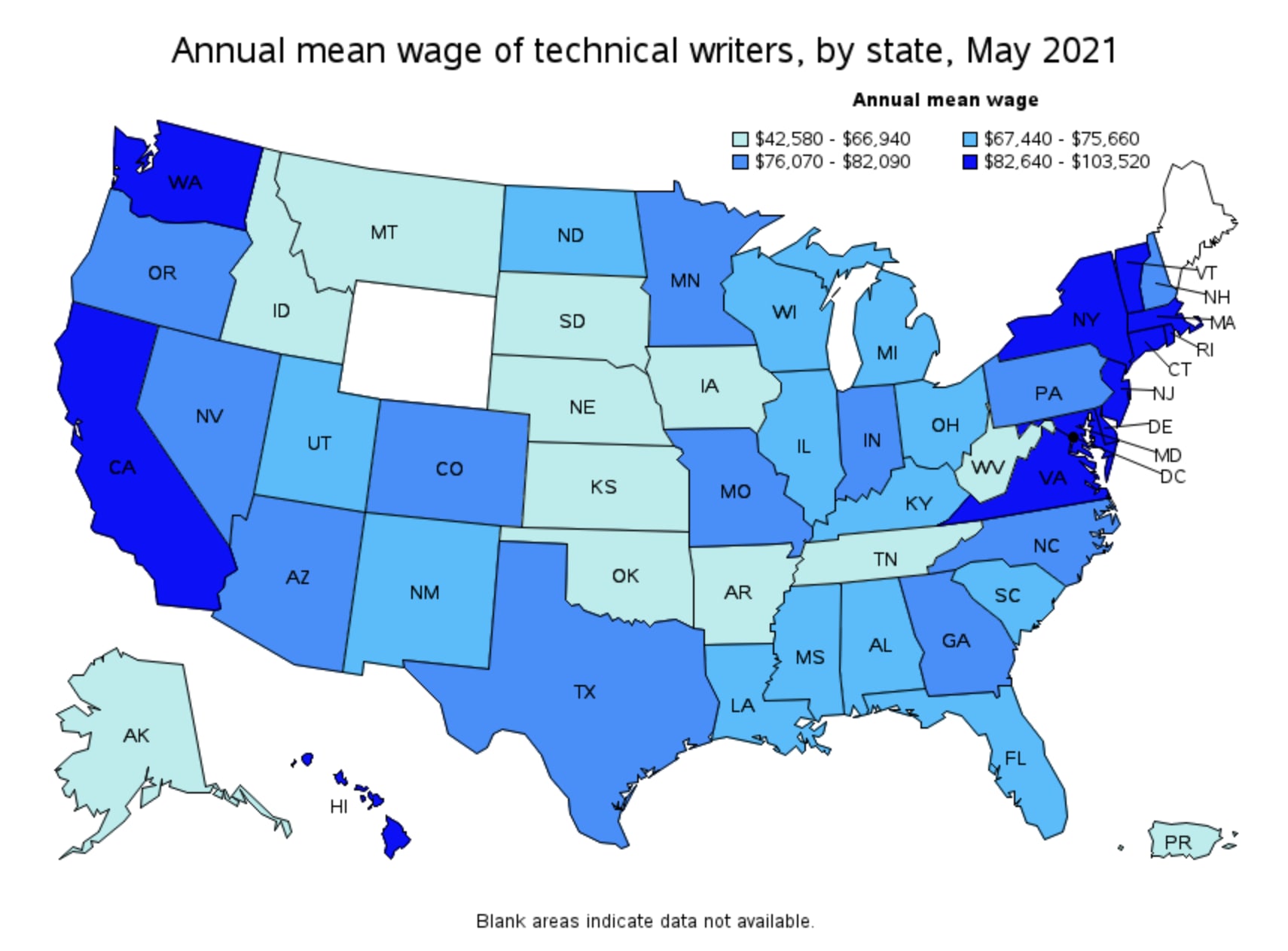
Source: BLS
BLS also found the top paying states for technical writers were:
Delaware ($103,520)
California ($100,730)
Massachusetts ($97,440)
Hawaii ($95,390)
District of Columbia ($91,120)
What is the difference between a technical writer and a technical editor?
It can be confusing to understand the true difference between a writer and editor with technical expertise. The biggest difference lies in their scope of work.

Here’s a quick overview:
Scope of work: Technical writers create content, while technical editors refine and improve it. It's important for both professionals to know their subject matter and be able to communicate well.
Focus: Writers specialize in creating content that's accurate, comprehensive, and well-organized. Meanwhile, technical editors aim to make sure the content is clear, consistent, and high-quality.
Skill set: Both technical writers and editors need good writing and communication skills, but technical editors have a more refined skill set, including proofreading and attention to detail. For technical writers, however, it's important to be proficient in research, content organization, and style adaptation.
Need a technical editor to perfect your technical documents? Hire an AI content editing pro on Fiverr.
Examples of technical writing
There are many types of technical documents a specialized writer can produce. These include:
Standard operating procedures (SOP)
Standard operating procedures (SOPs) are detailed guidelines outlining organizational tasks, promoting efficiency, consistency, and seamless operations. It may include everything from processing payroll to manufacturing guidelines, and calculating vacation time.
Case studies and white papers
A case study or white paper can be used to demonstrate one's knowledge in a particular area. In case studies, you look at a particular event or project and prove or disprove something. A white paper investigates any industry-specific challenge, question, or issue.
Business proposals
A business proposal is a formal document outlining a project or service offered to a potential client, aiming to solve a problem or meet specific needs.
Technical writing is vital in creating a clear, concise, and persuasive proposal, effectively communicating the objectives, methodology, timeline, and budget, ensuring the client fully understands the scope and benefits of the proposed solution.
Technical documentation
Repair manuals, owner manuals, maintenance guides, engineering specifications, technical manuals, and reference materials are examples of technical documentation.
Because this type of technical writing is intended for a particular audience, the writer must be aware of the reader's level of expertise, as well as have in-depth knowledge of the topic at hand.
End-user instructions
Software, computer components, or digital devices or consumer appliances come with user manuals that explain how to use them.
These are called end-user instructions, but they also include troubleshooting guides, assembly instructions, “dos and don'ts,” warranty details, and legal disclaimers.
These instructions must be written in user-friendly language so that a broad audience can understand highly technical info.
Technical reports
Many products also offer information on the product's origin, development, or structural or operational modifications, in addition to instructions and advice. Technical writers arrange and edit material for clarity and accuracy.
Feasibility studies and corporate reports
Feasibility studies and corporate reports, such as a company’s financial reports, involve thorough research by a writer. This information must then be presented in a way so that every level of employee, executive, or shareholder can easily understand it.
Therefore, visual aids such as graphs or charts are frequently included within them — especially when relating to topics including finance, timelines, and social or business practicality.
Research results
Products relating to the medical and pharmaceutical industries often come with documents detailing relevant laboratory research or findings. Because this form of technical writing typically includes details on medication combinations, side effects, and other critical health-related problems, exceptional attention to detail is necessary.
Policies and procedures
Businesses of all sizes require guidelines outlining their policies and procedures to manage their organization. Additionally, they use employee handbooks to help safeguard themselves against lawsuits from workers who claim they were unaware of particular rules and regulations.
These documents are presented by technical writers in simple, non-discriminatory language.
Literature reviews
A literature review can be used as a separate document or as part of a larger report. It’s a type of technical writing that summarizes what is known about a topic. Literature reviews consolidate and explain prior research and discoveries on a topic while highlighting research milestones, contradictory results, and what needs to be learned through additional research.
API documentation
API documentation shows how to integrate APIs into software applications and use them effectively.
By creating clear, concise, and accurate API documentation, technical writers make sure developers can easily find, use, and understand APIs. There are also plenty of AI writing prompt ideas to create this type of documentation and improve the writer’s workflow.
Hire a technical writer on Fiverr
How to become a technical writer.
Becoming a technical writer requires a combination of strong writing skills, technical knowledge, and dedication to continuous improvement.
By following the steps below, you'll be well on your way to a successful career in technical writing.
1. Seek education and training
Technical writing doesn't require a specific degree or years of experience. But many employers like candidates with a bachelor's degree in English, journalism, or a related field. Some technical writers have degrees in engineering, computer science, or other technical fields.
For aspiring technical writers, there are lots of certifications and workshops available, like the Society for Technical Communication (STC) certification or the American Medical Writers Association (AMWA).
2. Learn relevant skills
It's important to have a solid understanding of the technologies and industries you're writing about, but you don't have to be an expert in everything. Depending on the subject, you might have to learn new software or programming languages.
Technical writers need good research skills to gather information about the subject they're writing about. You might interview subject matter experts, read product specs, or do some online research.
Other useful technical writing skills include:
Attention to detail
Adaptability
Time management
Collaboration
AI content writing
Prompt engineering
3. Understand style guides
Maintaining consistency, clarity, and professionalism in technical writing requires understanding style guides. Knowing popular style guides like the Microsoft Manual of Style, Chicago Manual of Style, and APA Publication Manual ensures compliance with industry standards.
By mastering these guides, you can streamline your writing process, improve readability, and collaborate more efficiently with editors, designers, and subject matter experts.
4. Figure out your ideal work situation
There are a lot of work options for technical writers, depending on their preferences and goals.
They can work as in-house writers, creating specialized content and working closely with internal teams. Technical writers are employed in many fields, from sciences to information technology and manufacturing.
Or they can work as freelancers, enjoying flexibility and a variety of projects.
Others may join an agency, benefitting from a steady stream of assignments and a support network built in.
Look for freelance technical writing jobs on Fiverr or by networking within your industry. You can also check out job opportunities on social media websites like LinkedIn.
5. Create a portfolio
A strong portfolio is essential for showcasing your technical skills to potential employers. It demonstrates your ability to produce high-quality, professional documentation.
Your portfolio should include a variety of work samples, such as:
Instruction manuals
Technical guides
Whitepapers
Online help systems.
Include projects from different industries and technologies to show your versatility. You can showcase your portfolio on Fiverr and help companies find you easier online.
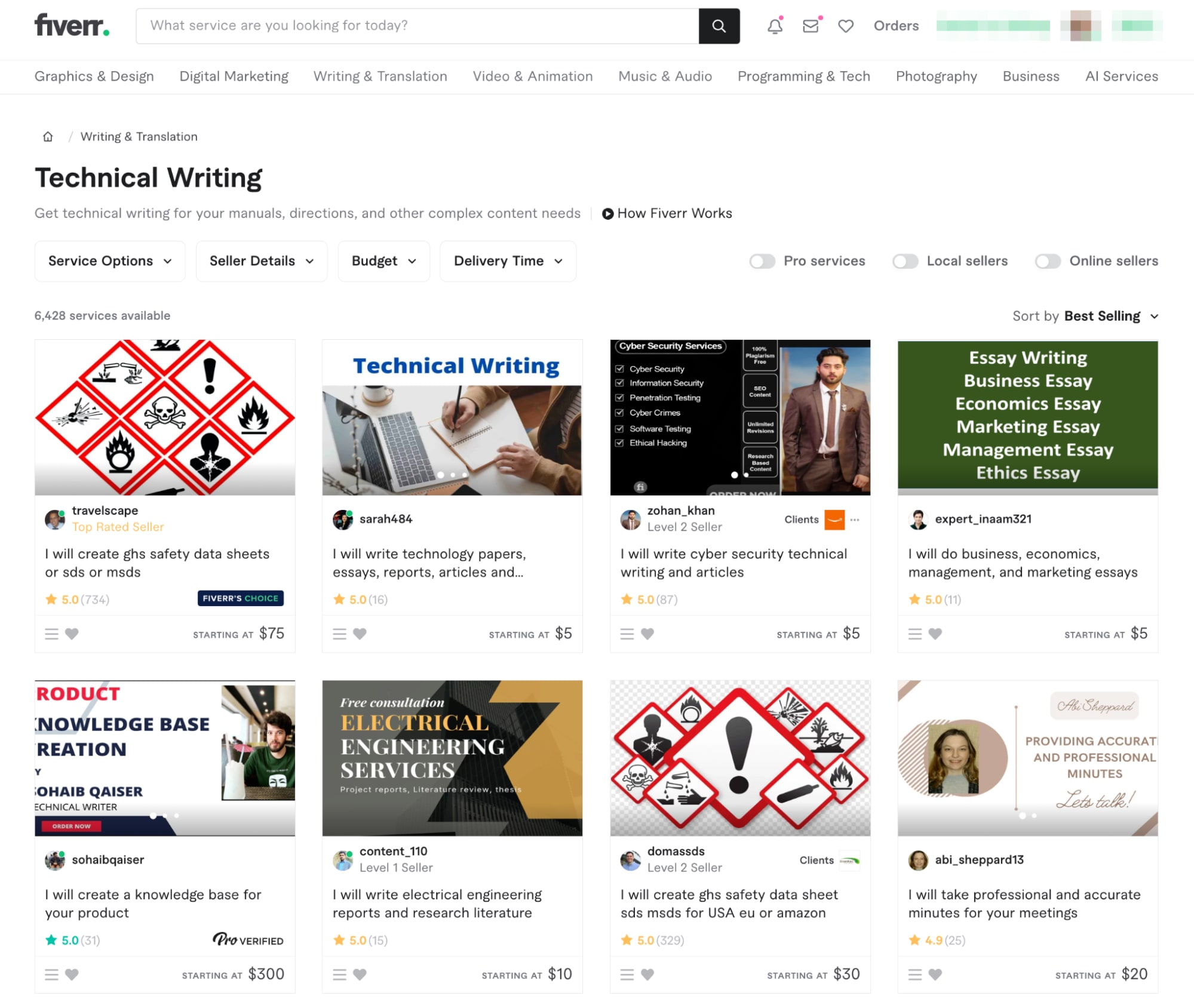
6. Focus on professional development
Building a professional network is essential for any career, and technical writing is no exception. Join industry groups, attend conferences, and participate in online forums to connect with other professionals and potential clients.
Continually develop your skills through professional development opportunities, such as workshops, conferences, and technical writing courses. This will help you stay competitive in the job market and improve your writing abilities.
Stay informed about the latest trends and technologies in your industry to ensure your work remains relevant and up-to-date. For example, these days you’d want to understand the implications of AI content marketing gigs and how they apply to your business.
Read industry blogs, subscribe to newsletters, and participate in online forums to stay informed.
Technical writing is vital to many businesses and sectors
As you’ve learned, technical writing simplifies the complex. It allows certain ideas, theories, practices, or procedures to be communicated in a manner that makes them easy to understand or accomplish.
It’s therefore highly relevant to any business or sector that utilizes user documentation, instructions, technical reports, feasibility studies and corporate reports, research results, policies and procedures, business plans, white papers, case studies, literature reviews, proposals, and more.
Technical writing has existed since written languages were invented, however, it continues to grow rapidly in popularity—especially in our advancing era of telecommunications. The practice is showing no signs of slowing down and will continue to be an integral part of our world for decades to come.
Want to hire a technical writer for your business? Sign up for a free Fiverr account today.
Technical writing FAQ
What is meant by technical writing.
The process of writing technical content involves communicating complex information in a clear, concise, and accurate manner. It’s a form of communication for many educational, professional, or instructional purposes.
What are the 5 components of technical writing?
The five components of technical writing are purpose, target audience, content, organization, and style. These components help ensure that information is effectively communicated to the reader.
What are the 7 types of technical writing?
The seven types of technical writing include user manuals, standard operating procedures, technical reports, white papers, proposals, online help documentation, and scientific articles.
What is an example of technical writing?
A technical writing example is a user manual explaining how to use a specific computer software or electronic device. The goal is to make sure users understand and use the product well.
Related Guides

About author
Michael keenan content writer and strategist.
Michael is a marketer and entrepreneur living in Guadalajara, Mexico. Through storytelling and data-driven content, his focus is on providing valuable insight and advice on issues that readers care about most.
Get the Reddit app
For people who take the unbelievably complicated things that scientists and engineers devise and make it understandable for non-technical people.
How to Start a Portfolio?
I am an aspiring technical writer. I received my degree in technical writing in 2017, interned in instructional design, and since then have had no luck breaking into the field. Most of my “portfolio” includes projects from my undergrad, none of which were remotely technical (more like essays, a board game instruction manual, and one small iFixIt guide).
Overall my degree didn’t even seem to touch technical writing and so I have nothing to show for it, and I’m no longer a “recent” college grad or current student so an internship seems out of the question. I want to start creating a portfolio but have had no luck on Upwork. I’m considering now making a Wordpress site and creating examples, but have no idea where to even begin with that. Any and all advice would be greatly appreciated!

IMAGES
VIDEO
COMMENTS
Learn how to create a great tech writing portfolio to showcase your skills and land a job. See five examples of technical writers with different backgrounds, projects, and styles.
ALL or much of your published writing. A good technical writing portfolio shouldn't just show your best work if it's like 10 articles. Employers in 2023 are looking for quantity and quality. If possible, include all or most of your articles/blogs/docs pages/guides/manuals in your portfolio.
Learn how to create a stunning portfolio that showcases your technical writing skills and experience. See 5 impressive examples of digital portfolios for different levels and industries.
A technical writing portfolio is simply a showcase of your best tech writing samples and should contain at least 3-5 samples. Regardless of your level of experience, here are some general guidelines to keep in mind when putting together your samples: Put your best foot forward: As I said, your tech writing portfolio should be a showcase of your ...
2. Rolando Montecalvo. This portfolio shows extreme versatility, wide-ranging interests, and the ability to find the right tone for every audience. It has a very strong bio and a great range of projects. Take note of the tone you use in your bio, as it should be reflective of the work you're looking to land.
A technical writing portfolio in this context is simply a collection of the best technical samples you have worked on. These samples could be documentation, technical content, whitepapers, user guides, manuals, etc. A good technical writing portfolio contains only relevant, up-to-date content that showcases your best writing ability in the ...
Your bio: What to include. Your short biography should be in the "About" section of the portfolio. It should illustrate your past, present, and future aspirations. Tell a story about how you got into tech, what you are working on now, and what roles you are trying to land, in a positive light. Write about your current tech stack, and what ...
Portfolio Examples Explore this selection of handpicked portfolios built with Contentre. The range of themes means all portfolios are personalized, branded, and different. ... Spend less time managing your freelance technical writing career and more time focused on your writing and getting more clients. Company. Ambassador Program; Contentre ...
In this article, we discuss challenges you might face when creating a technical writing portfolio. We are also going to discuss 10 tips with examples from the market to show you how to create a good portfolio. Technical Writers vs. Portfolios. Portfolios are a way to market your skills. However, many technical writers lack marketing skills.
Portfolios and resources mentioned:- My GitHub portfolio: https://youtu.be/68ddwfpXHrE- Swapnil Ogale's portfolio: http://swapnilogale.github.io/- Life as a ...
Explore 20 Tech Technical Writer Portfolio Examples. Dive into a diverse collection of 20 meticulously curated Tech Technical Writer Portfolio Examples, each showcasing the breadth of creativity and expertise within the field. Whether you're looking to revamp your current portfolio or are crafting one from scratch, these examples serve as a ...
The different types of technical writing have unique characteristics that you can easily learn and master effectively. 1. User Manuals. User manuals or instruction manuals come with various products, such as consumer electronics like televisions, consoles, cellphones, kitchen appliances, and more.
Building a technical writing portfolio . Summary: A technical writing portfolio is the best way to showcase samples of your work and skills. If the documentation you create is publicly available, then its easy to just add their links in your CV. However, if the documentation is not public, then creating a portfolio is the best way to showcase ...
Each portfolio exemplifies unique approaches to presenting technical content and projects, ensuring you find an example that resonates with your personal brand and professional aspirations. Click on any name to see their portfolio in full! Analyst. Anchor. Anchorperson. Author. B2B Content. B2B Content Marketer. B2B Content Writer.
You should tell about your previous projects, your experience and use the portfolio to highlight your success in technical writing. Develop Your Portfolio. Even if you got the desired job, do not ...
Karen Rempel is a New York-based technical writer with over 20 years of experience. She showcases her online and printed documentation projects in various domains, such as banking, software, engineering, and publishing.
Emily presents short and precise, easily understandable, and to the point content in her portfolio. In the upper side of each example, she presents the type if it is an article, UX writing, UX content strategy, guide, or marketing campaign. At the bottom of each example, the heading is mentioned.
The #1 social media platform for MCAT advice. The MCAT (Medical College Admission Test) is offered by the AAMC and is a required exam for admission to medical schools in the USA and Canada. /r/MCAT is a place for MCAT practice, questions, discussion, advice, social networking, news, study tips and more.
9. Reply. Award. Share. hollyofcwcville. • 1 yr. ago. Create a portfolio with mock content that's diverse and represents what you've learned to do. This should also demonstrate your thought processes and communication skills when approaching the content, sending for review, revising it, etc. You may not have experience but you can ...
Here are top 10 technical writing tips for writers to create high-quality technical documents with best practices and common mistakes. ... This applies to technical writing as well. Include examples to make your technical writing engaging, user-friendly, and accessible. Examples help the reader quickly grasp complex concepts by showing how they ...
Although depending on how they are written and their quality, they could be good samples for a portfolio for professional writing that involves writing copy for companies and non-profits for their websites. But that is a different style of writing than most technical writing. 2. Reply.
Clear: Technical writing conveys information clearly and concisely, leaving little room for interpretation. The language is straightforward and succinct. Straightforward: Facts are presented in a direct and to-the-point manner. Precise: Technical writing uses specific terminology to precisely describe objects and processes.
This is easy. Pick something on your desk and write a manual for it. A stapler, your computer monitor, your stupid fu__ing fidget spinner. Anything! Create it in multiple mediums as well. Make a single page Quick Start Guide, do some diagrams, make an infographic, make some walkthroughs. 2.
For your portfolio, create a sample course or two with a couple of pages including exercises and activities. Show your potential employers your skill in making something complicated into digestible bits. I would stay away from showing undergrad work at this point unless it's pertinent to the position. 14.